Sock It To Me!
Being a gentleman is often defined by attention to detail, and one detail that should never be overlooked is your socks. The correct socks can elevate any ensemble to the status of a sartorial masterpiece. But the wrong pair can destroy the overall look of an outfit, making it seem amateurish and just plain “off.”
- Sock It To Me!
- A Brief History of Socks
- New from Fort Belvedere! The Fall 2022 Sock Collection
- Dress Sock FAQ
- Why You Should Wear Classic Dress Socks
- The Hallmarks of Quality Dress Socks
- Stop the clock with exceptional and colorful clocks!
- Common Sock Materials
- How To Elegantly Combine Socks, Shoes, and Trousers
- The Right Socks for the Right Shoe
- Check out our Free eBook!
- The Benefits of a Sizable Sock Drawer
- Buy in Bulk and Save with Fort Belvedere!
- How to Store and Organize Socks
- Dress Sock Buying Guide
- The Do’s and Don’ts of Dress Socks
- The Do’s and Don’ts of Dress Socks
- Conclusion
This guide will show you exactly how to utilize dress socks to their fullest potential, both for everyday and formal wear. You will learn what defines a dress sock, how to select quality dress socks, and how to incorporate dress socks correctly in your personal style. You will also learn about the fascinating history of this unique menswear accessory and be introduced to some of the very best brands.
A Brief History of Socks
Socks Were First Worn by Prehistoric Man
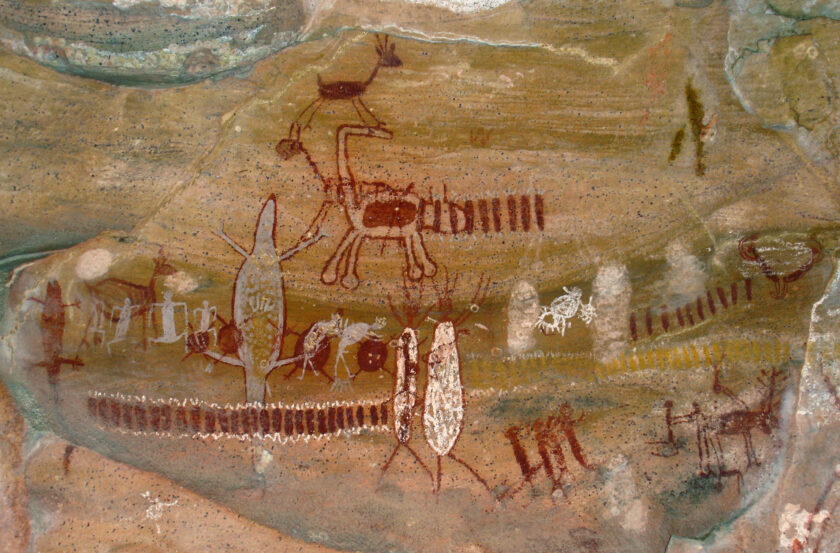
The earliest socks were worn by prehistoric men and consisted of simple animal hides that were loosely wrapped around the feet. Tied at the ankle, the skins consisted of the warmer and more comfortable parts of the animal skin, sometimes including the fat layer for extra insulation.
The purpose of these rudimentary socks was, of course, to keep the feet warm but also to protect them from the harshness of the rougher hides and natural fibers used to make primitive shoes.
Socks in Antiquity: Yes, They (Sometimes) Wore Them with Sandals
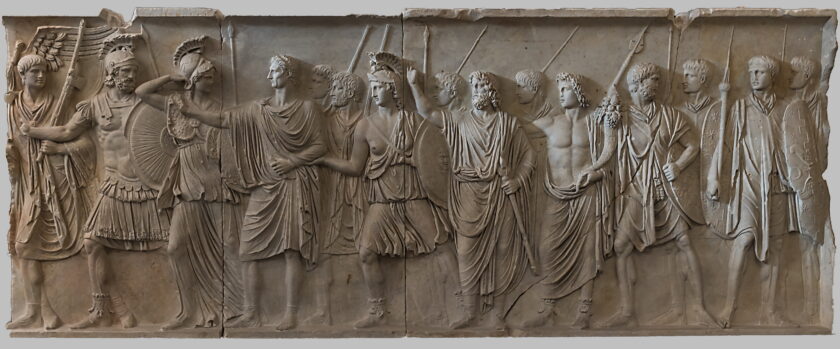
Many of the great civilizations of the Ancient Period, spanning from approximately 4000 BC to 400 AD, were located in warmer climates and, as such, are most often associated with sandals and similar footwear in popular conceptions. Socks were, therefore, less essential for these civilizations, although they were still known: Greeks and Romans would sometimes wear open-toed socks with sandals to prevent chaffing from the leather straps.
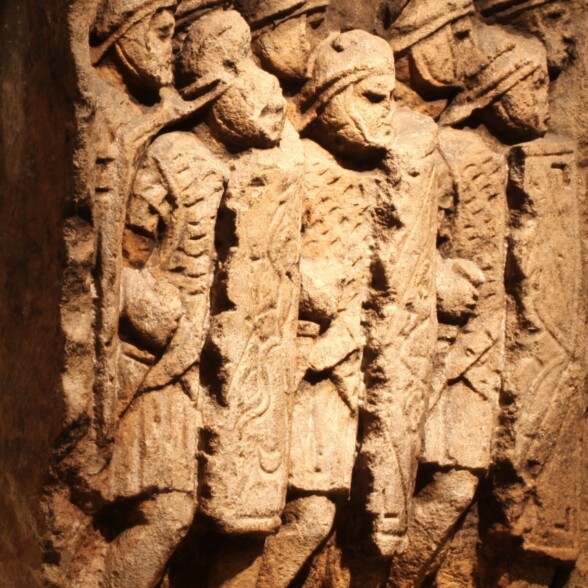
The socks of the Roman Legion
Udones
The massive Roman Empire controlled territory across the world, including in the colder zones of Northern Europe. There, Roman legionaries were supplied with thick wool socks, called udones, that were worn under their military sandals and boots. These socks helped to keep the feet warm and also reduced chafing.
Socks: A Status Symbol of the Middle Ages and Early Modern Period
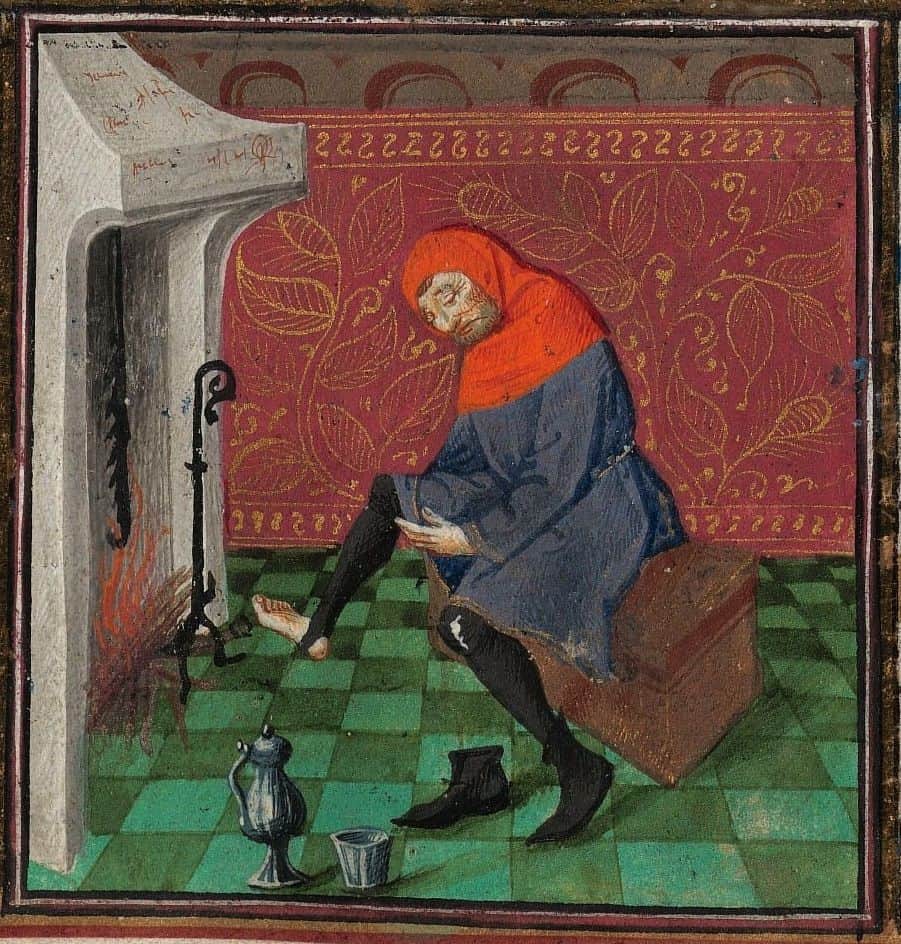
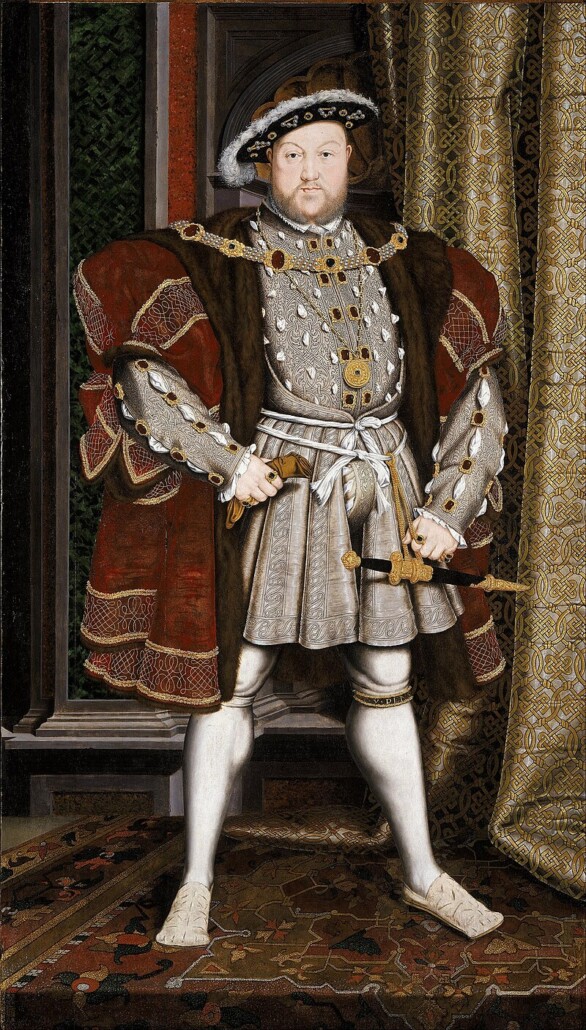
By the Early Middle Ages, socks were common in the generally colder climates of Western and Eastern Europe. These socks were worn for a variety of purposes: under the boots of knights, soldiers, and horsemen, they helped to prevent the unpleasant rubbing of the skin. Colorful and highly decorated socks also became a status symbol, as they were expensive to make due to labor costs and fine materials. These socks were reserved for the nobility and other affluent persons and were a sign of wealth and taste.
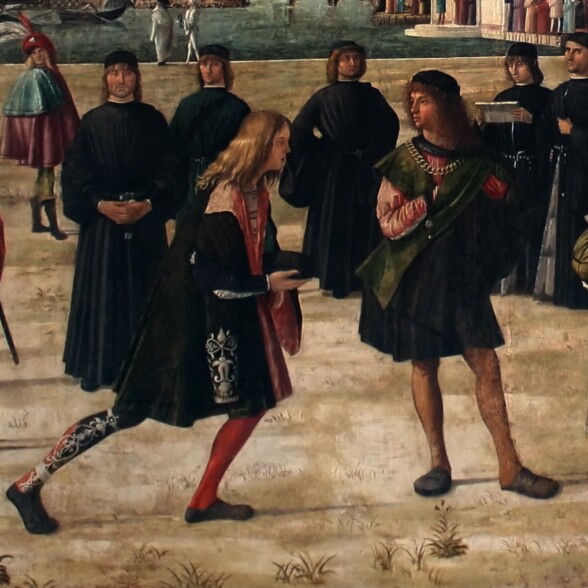
The stocking leagues of Early Modern
Venice
The Renaissance saw the rise of unique and colorful socks that would rival some of the craziest of Crazy Socks seen today. Nowhere was this more true than in Venice, Italy, where socks were so bold and dramatic that they became the emblems of social clubs. Compagnie della Calza, or Stocking Leagues, were groups of young noblemen who hosted parties, public events, and charitable works. Each club was identified by the stockings worn by its members: many featured unique patterns, unusual colors, and even fanciful depictions of plants, animals, and other figures.
White Hose: The First Dress Socks?
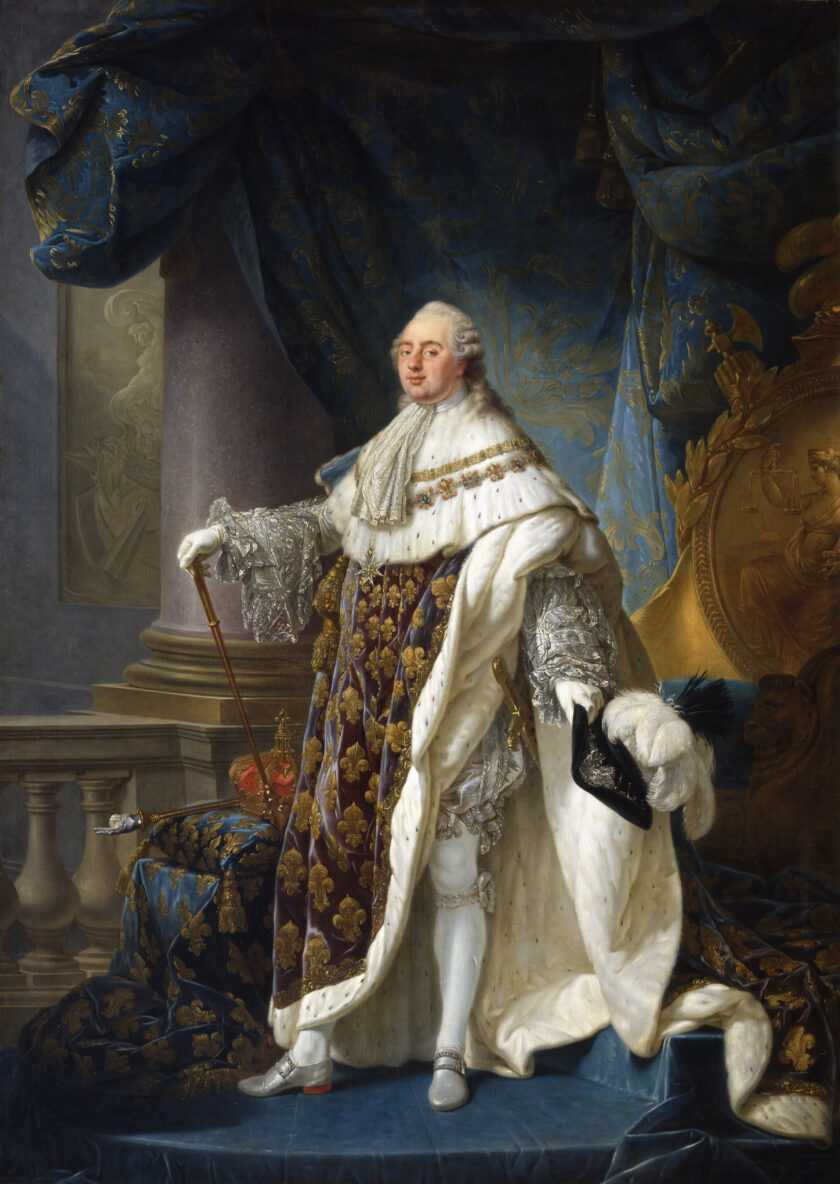
At the start of the Early Modern Period, colorful socks and stockings began to give way to pure white examples. White was a color closely associated with wealth because it was difficult to dye and even more difficult to maintain. After all, if one had to engage in manual labor, white clothing could easily become soiled, and even with regular or modest wear-and-tear, white clothing requires regular cleaning.
White socks, therefore, became emblematic of wealthy and powerful men. It should come as no surprise that trousers, such as breeches or culottes, were cut short in the legs to showcase the fine, blinding white socks of the wearer.
White Fabric: The Original Status Symbol

The neverending Struggle to
Keep Socks Up
Because of their fine, light material, hose were tied into place with ribbons or string just below the knee to keep them up. Thicker socks could be knitted with a cuff that stretched around and held to the calf, but eventually, this neck would be stretched out, and socks would become loose and floppy, necessitating the use of some kind of support system. This issue was eventually mitigated with the invention of synthetic, elastic materials in the 20th century, although even these fabrics can eventually become stretched-out.
Knitting Machines Make Socks More Affordable
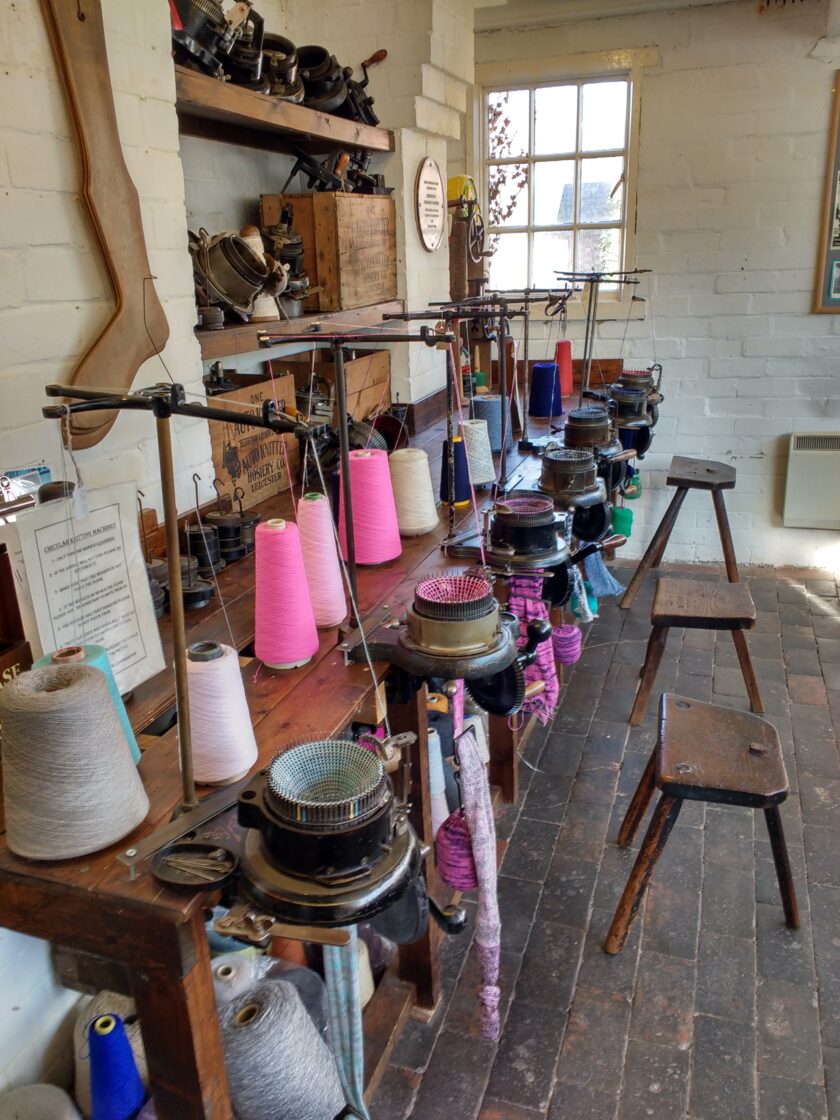
Until the Industrial Revolution, all socks had to be made by hand, usually through knitting. The quality and material of these socks varied based on class: common people usually wore socks knitted by themselves or their family members from wool, while the wealthier classes could afford artisanal socks made by craftsmen from luxury materials like silk and fine cotton.
Socks remained relatively difficult and expensive to make, however, and so many men, even relatively wealthy men, might only own two or three pairs of socks at any one time.
In the 18th century, the first mechanical processes for making socks were invented. These machines functioned by first knitting two flat panels of cloth that were the two halves of the sock. These panels would then be sewn together with a seam that ran along the back of the calf. These knitting machines helped to drastically reduce the cost of socks, increasing their availability.
The First Circular Sock Knitting Machines Appear


The large seam that ran down paneled socks could be very uncomfortable, creating a weak point in the knitted sock that could come apart. In the 19th century, this issue was solved with the invention of the circular sock-knitting machine, commonly referred to as a CSM. This device allowed the user to create seamless, tubular socks. Handwork was still needed, however, at the reinforced heel to give the sock structure and to close off the toe area.
These machines used a series of inter-functioning needles to knit the socks. The earliest machines consisted of 72 needles that generally used thicker thread, resulting in a bulkier sock. Eventually, newer machines were developed with up to 280 needles that could produce extremely fine socks that were of the very highest quality.
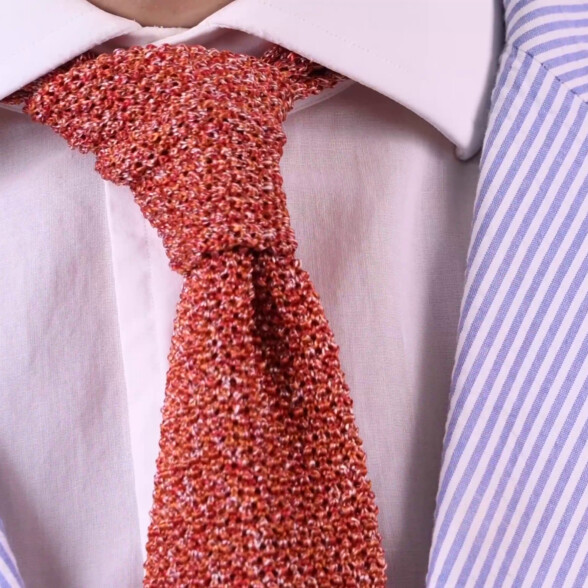
A Sock-knitting machine now makes
Neckties?
Sock-knitting machines of the highest possible quality were being made throughout the late 19th and early 20th centuries. These precise instruments produced superior garments when in the hands of skilled artisans. One such over-100-year-old machine was repurposed from making socks to making neckties and now knits the Cri de la Soie silk knit ties sold by Fort Belvedere.
Nylon Revolutionizes the Sock Industry
![Two Women In The Netherlands Examine Pairs Of Nylon Stockings 1946 Image Credit Wikimedia Two women in the Netherlands examine pairs of Nylon stockings, 1946 [Image Credit: Wikimedia]](https://www.gentlemansgazette.com/wp-content/uploads/2022/11/Two-women-in-the-Netherlands-examine-pairs-of-Nylon-stockings-1946-Image-Credit-Wikimedia-1024x1030.jpg)
Nylon is the generic name for a group of thermoplastic synthetic fabrics with silk-like qualities. First developed in the late 1920s, it was introduced to the world in 1939 as a “wonder fabric” for hosiery, both as women’s stockings and men’s dress socks.
Because of its extremely low costs, unique properties, and how easy it was to work with, nylon made it possible to produce extremely fine men’s socks on a scale previously unimaginable. Nylon could also be blended with other more common sock materials, combining its stretch, durability, and fineness with the properties of the blended fabric.
Tens of millions of pairs of nylon dress socks were soon pouring out across the world, and to this day, nylon remains one of the most popular fabrics for men’s dress socks. The very best men’s socks, however, are still made from 100% natural fibers like cotton, wool, cashmere, silk, or blends of the same.

From Wonder fabric to blunder fabric
Nylon
When it was first introduced, nylon was treated like a miracle product: it had the relative sheen and brightness of silk with the durability of a much more coarse fabric, all at an extremely low price. Nylon products, like men’s dress socks, were soon flying off the shelves. Within a few years, however, nylon began to lose its luster because it tends to be very stuffy and constricting, with poor breathability.
Learn more about the environmental impact of synthetics
Twentieth Century Dress Sock Fashions & Fads
The Timeless Dress Socks of the Golden Age of Menswear
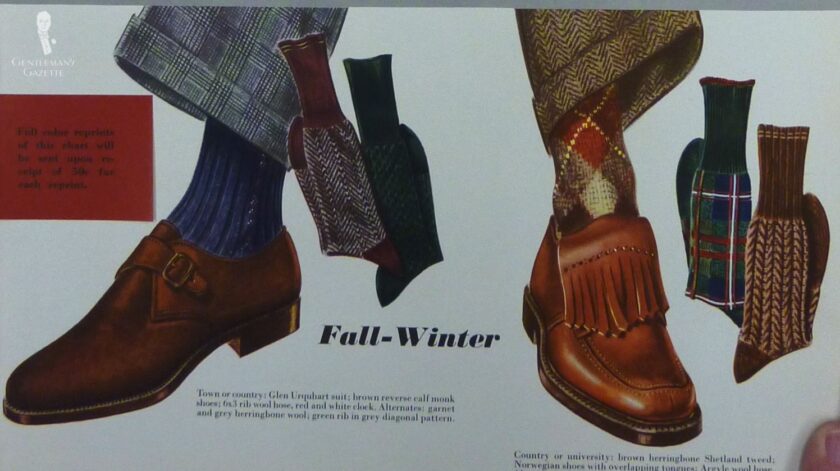
During the Golden Age of Menswear, dress socks were just one of the many accessories that were standardized into the Classic styles that we still revere today. Thanks to reduced production costs, men could afford entire drawers filled with unique and versatile socks that could suit a variety of occasions.
Around this time, a stronger differentiation also developed between fine dress socks and specialized other types of socks. Plain white cotton socks with a ribbed cuff, for instance, were developed as athletic wear to be worn with athletic shoes like tennis shoes or sneakers.
“Above everything, don’t wear white socks”
Emily Post, 1922
Dress socks were the preponderance of socks in these Classic wardrobes. A gentleman would have a variety of day-dress socks that he could wear at work or while running errands. He would also have a collection of evening-dress socks, suitable for more formal occasions like dates, suppers, and nights out.
Formal evening socks were at the pinnacle of the dress sock hierarchy and were the finest, most formal socks a man could own. Often made of silk, these socks were worn on only the most refined Black and White Tie occasions.
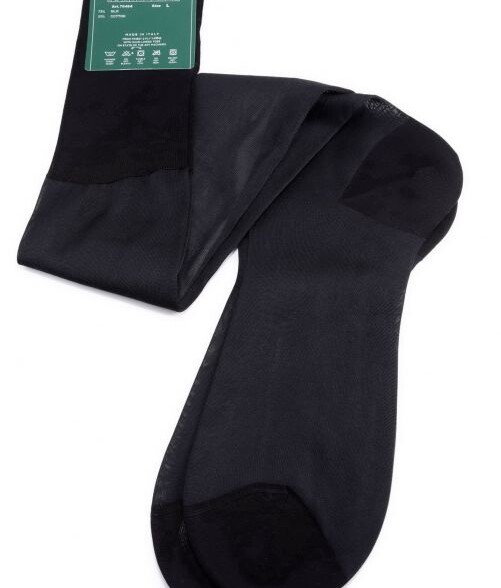
Learn what makes these the
Finest Socks in the World
Available exclusively from Fort Belvedere, these luxurious socks are made from 75% silk and 25% Egyptian 2-ply fil d’Ecosse cotton, guaranteeing both an elegant look and exceptional durability. Woven on heritage machines with 280 needles, we know that these are truly the finest socks in the world. Learn more here.
Dress Socks in the Second Half of the Twentieth Century

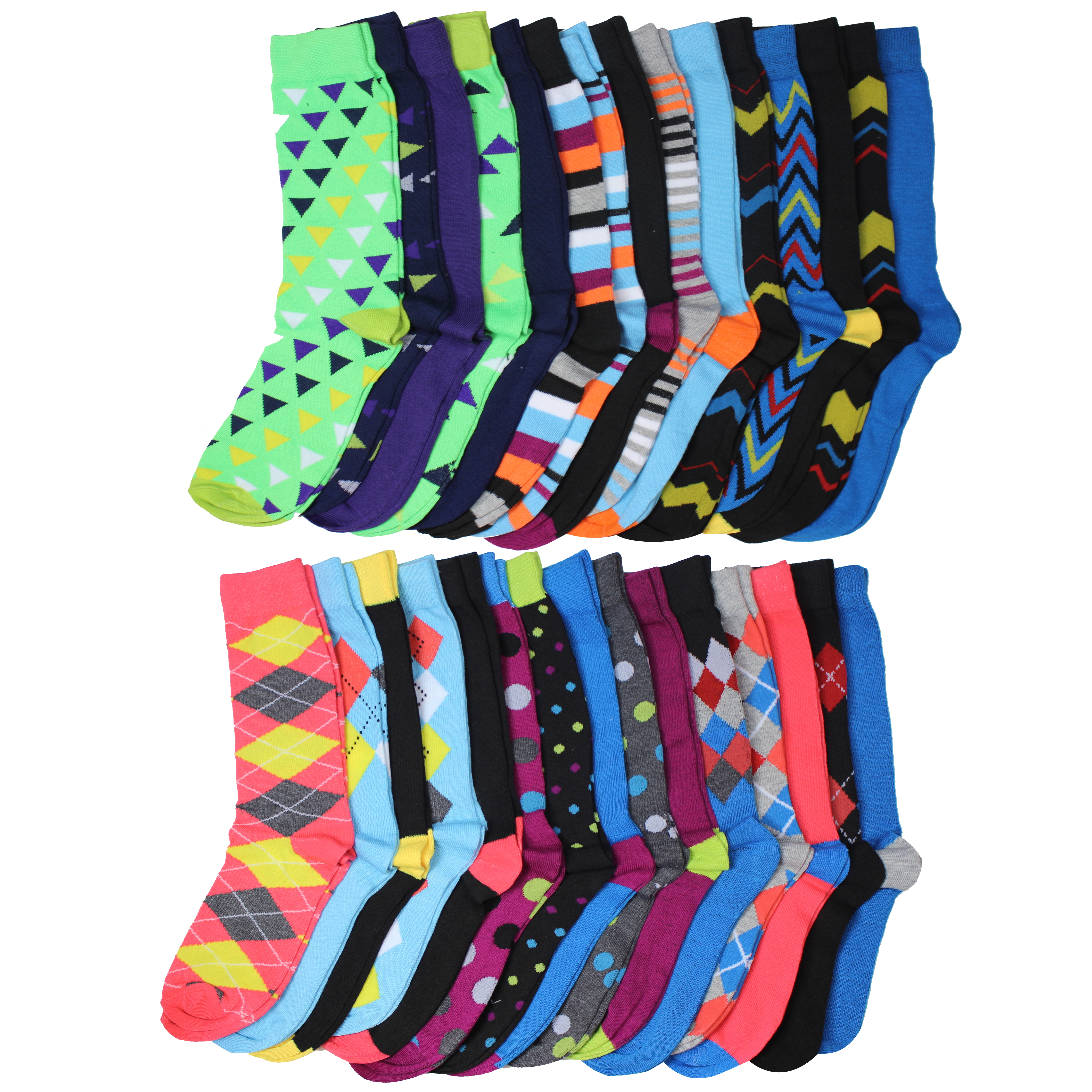
After the 1960s, the increasingly casual nature of menswear saw two unique trends in dress socks. The first was the proliferation of novelty, or “Crazy,” socks. As production costs for socks decreased even further, it became feasible to manufacture socks that featured outlandish colors, ludicrous designs, and even humorous or ironic images like cartoon characters. These wacky socks became a common gag gift and were popularized as a way to inject extreme color into menswear, but to keep costs down, they were often made from cheap materials.
In reaction to these unusual socks, many more formal dress socks became even more sedate and even bland. Socks that were considered appropriate for business were reduced to a minuscule color palette of black, dark grey, and navy, and patterns, which had been common during the Golden Age of Menswear, largely disappeared.
Therefore, men’s dress socks were relegated to two extremes: garish novelty socks with crazy designs and colors and frankly boring business socks with little personality.
Dress Socks Today
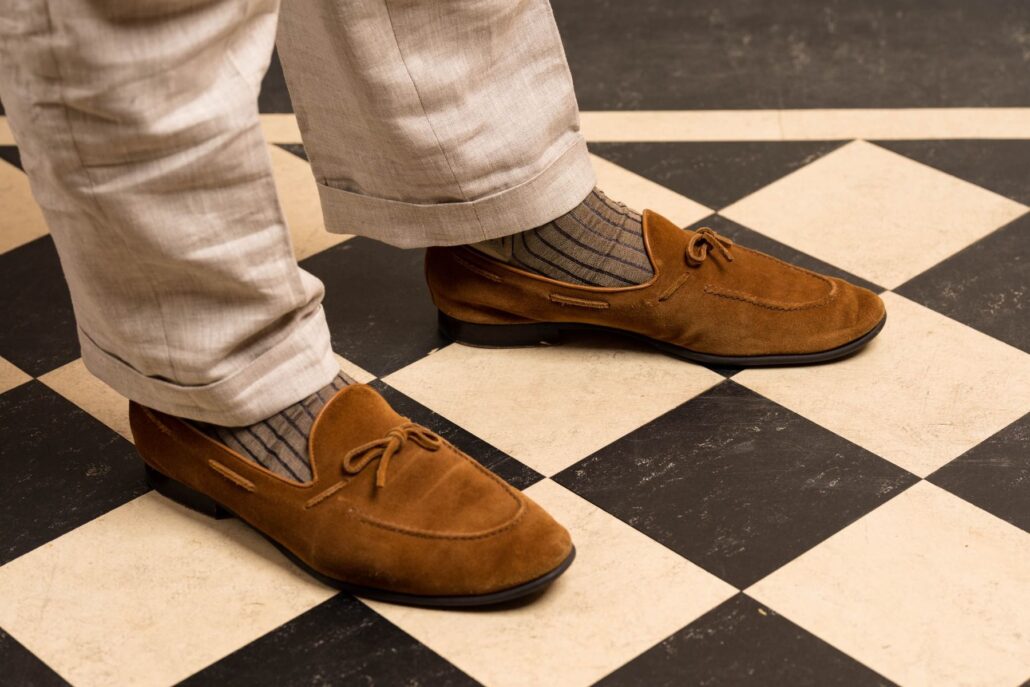


Between increasingly casual standards of dress and the proliferation of underwhelming dress socks, most men today are content to limit their sock collections to the ever-popular white tennis socks and a few plain solid or ribbed black, brown, or grey socks.
Fortunately, revived interest in Classic Style has led to a Sock Renaissance in recent years. Classic color palettes, patterns like herringbone, argyle, and birdseye, and a greater emphasis on quality are returning to dress socks. As a result, many of the dress sock styles typical of the Golden Age of Menswear have made a dramatic return.
Now more than ever, it is essential that well-dressed gentlemen understand what constitutes a quality, Classic dress sock. Fortunately for you, that is exactly what this guide is designed to do.
New from Fort Belvedere! The Fall 2022 Sock Collection
Exceptional Dress Socks to Suit Every Occasion

Fort Belvedere Shadow Stripe Ribbed Socks in Bright Blue and Yellow Fil d'Ecosse Cotton
Combining versatile blue with a brilliant pop of sunny yellow, these socks can be dressed up or down but make a big impression at every level of formality. Perfect for the warmer months, they look just as good with a suit as they do with a polo and chinos.

Fort Belvedere Navy and Khaki Shadow Stripe Ribbed Socks Fil d'Ecosse Cotton
Get down to business with these dress socks that blend the dignified air of navy with the bright but neutral tones of khaki. Perfect for adding refinement to a casual ensemble or unexpected visual interest to a more formal one, these socks are the most understated of statement pieces and are just at home on a night out as they are in the boardroom.

Fort Belvedere Khaki and Navy Shadow Stripe Ribbed Socks Fil d'Ecosse Cotton
When it comes to maximizing versatility when worn with casual trousers, few color combinations will have khaki and navy beat. The knaki provides a neutral foundation that bridges and brightens the look, while the navy is the perfect color to pick out any blues in the rest of your outfit.

Fort Belvedere Brown and Bright Blue Shadow Stripe Ribbed Socks Fil d'Ecosse Cotton
Brown might be one of the most underutilized colors in menswear,but with these chocolate brown socks with bright blue stripes, it doesn’t have to be for you. The dash of color provided by the blue adds zest, while the rich shade of brown keeps the look more sedate, helping these socks function at any formality level.

Fort Belvedere Shadow Stripe Ribbed Socks in Black and White
Step out in style with dress socks that have all of the formality of conventional black dress socks but considerably more panache and personality. Whether worn with a dark business suit or more casual evening wear, such as Creative or Festive Black Tie, these black and white socks prove that formality can still be fun.
See all the very latest from Fort Belvedere!
Dress Sock FAQ
What are dress socks?
Dress socks are socks intended to be worn when a man is, relatively speaking, dressed up to go out. They can include socks worn with a business suit during the day or socks worn with a tuxedo, but also socks worn with more casual looks.
How do dress socks differ from other types of socks?
At their most basic level, the majority of dress socks differ from other socks in that they are not specialized. Ribbed white gym socks or crew socks, for instance, are specially designed for use during athletic endeavors. Heavy wool socks are designed to keep the feet warm during very cold weather. Hiking socks are designed to be worn with hiking boots. Most dress socks, on the other hand, are intended to be worn during the day as part of a gentleman’s everyday ensemble, although there are more formal dress socks reserved for more formal Black and White Tie occasions.
Can I wear other types of socks in place of dress socks?
No, you cannot. Casual socks, like athletic socks, crew-cut socks, ankle socks, no-show socks, or similar socks, simply lack the formality typical of dress socks. Wearing such socks with more formal ensembles will appear very jarring and can effectively ruin your entire outfit.
Aren’t dress socks only for fancy clothes?
No! While some dress socks can be fancy, not all dress socks have to be worn with formal ensembles. In fact, many dress socks can look lovely with a more casual outfit, like chinos and a long-sleeved shirt or shorts and a polo.
Why should I wear dress socks?
In addition to looking more elegant and refined than casual socks, dress socks are often usually more comfortable. This is because quality dress socks are made from breathable, natural materials and knitted to a pleasant and aesthetically-pleasing thickness.
Aren’t dress socks uncomfortable?
No! The assumption that dress socks are uncomfortable comes from men wearing cheap and poorly made dress socks. Low-quality dress socks are uncomfortable because they are made from cheap fabrics that constrict the foot and make it feel stuffy. They also tend to be itchy and irritating. Quality-made dress socks have no such issues.
Why are many dress socks so long and sit so high up the leg?
Classic dress socks are designed to sit over the calf, just below the knee. This positioning ensures that the socks do not slip down over the calf, which often happens with shorter socks because the socks have a more secure grip when worn higher up the leg. In effect, it is the height of dress sock cuffs that helps them stay in place and prevent them from constantly falling down.
What makes a dress sock “Classic?”
A Classic dress sock allows for the full stylistic potential of the dress sock. It is a quality, durable article made from natural materials that features a versatile design with colors, patterns, and textures that will complement many other articles and fits within a standard Classic wardrobe.
What patterns are typical of Classic Dress Socks?
The most versatile classic sock patterns are stripes, two-tones, and clocks. Argyle, herringbone, birdseye, plaid, checks, and similar patterns are also common but are not appropriate for as wide an array of occasions.
What color socks are best for different outfits?
Generally speaking, dress sock color should be determined by the relative formality of the event you are attending. For more formal events, darker colors like black, dark grey, and navy are the most appropriate. To emphasize the distinction between formal and informal events, you should therefore be sure to wear your more colorful socks on casual occasions to take advantage of all of the options available to you.
What are common materials for dress socks?
The most common dress sock materials are cotton, wool, silk, cashmere, synthetics, and blends. As a general rule, synthetics ought always to be avoided.
Do dress socks have to be ribbed?
No. While ribbing is a sign of a quality dress sock, it is not a necessary feature in all dress socks.
Which socks should be worn with formal shoes?
For formal events like Black or White Tie, a pair of black day socks is insufficient: while the color may be correct, day socks are too thick and rough-textured for evening affairs of that caliber. Instead, such events call for genuine formal evening socks made of silk or a silk blend. These socks are the correct color as well as the correct texture and thickness for elegant events.
How do I keep from getting holes in my socks?
Buying high-quality, well-made socks is the first step in ensuring no holes. Next, make sure that you keep your dress socks safely inside shoes or slippers when wearing them because the delicate fabric was not designed to be directly exposed to the floor. It is also a good idea to regularly rotate socks so that no one pair is overworn.
Why You Should Wear Classic Dress Socks
In a world centered around perceived comfort and low costs, you might be wondering why you ought to bother with stylish, classic dress socks at all: aren’t they just for religious services and funerals? Of course, this could not be further from the truth, as illustrated by our following three points that highlight what makes dress socks such remarkable and versatile accessories.
Aesthetics
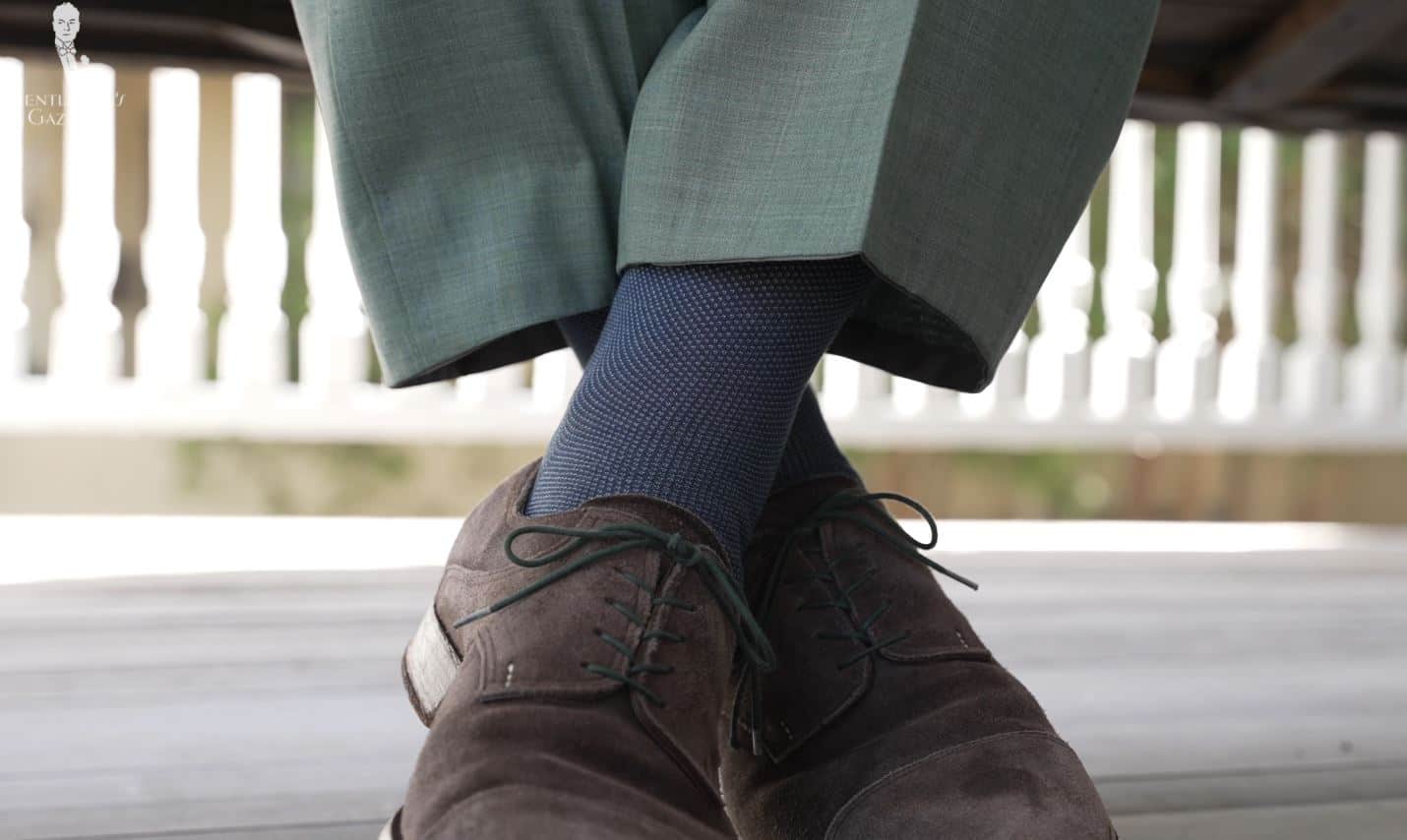
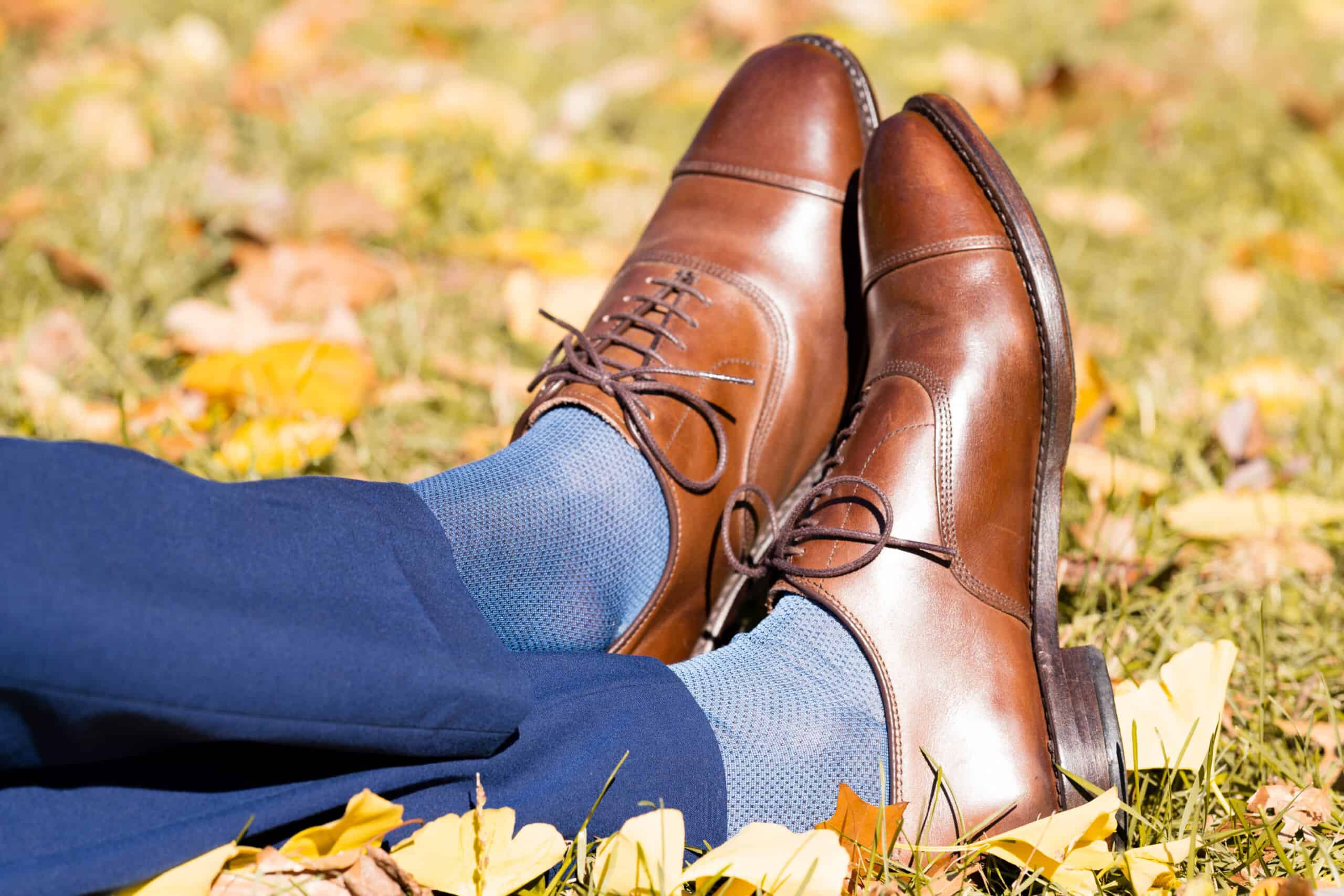
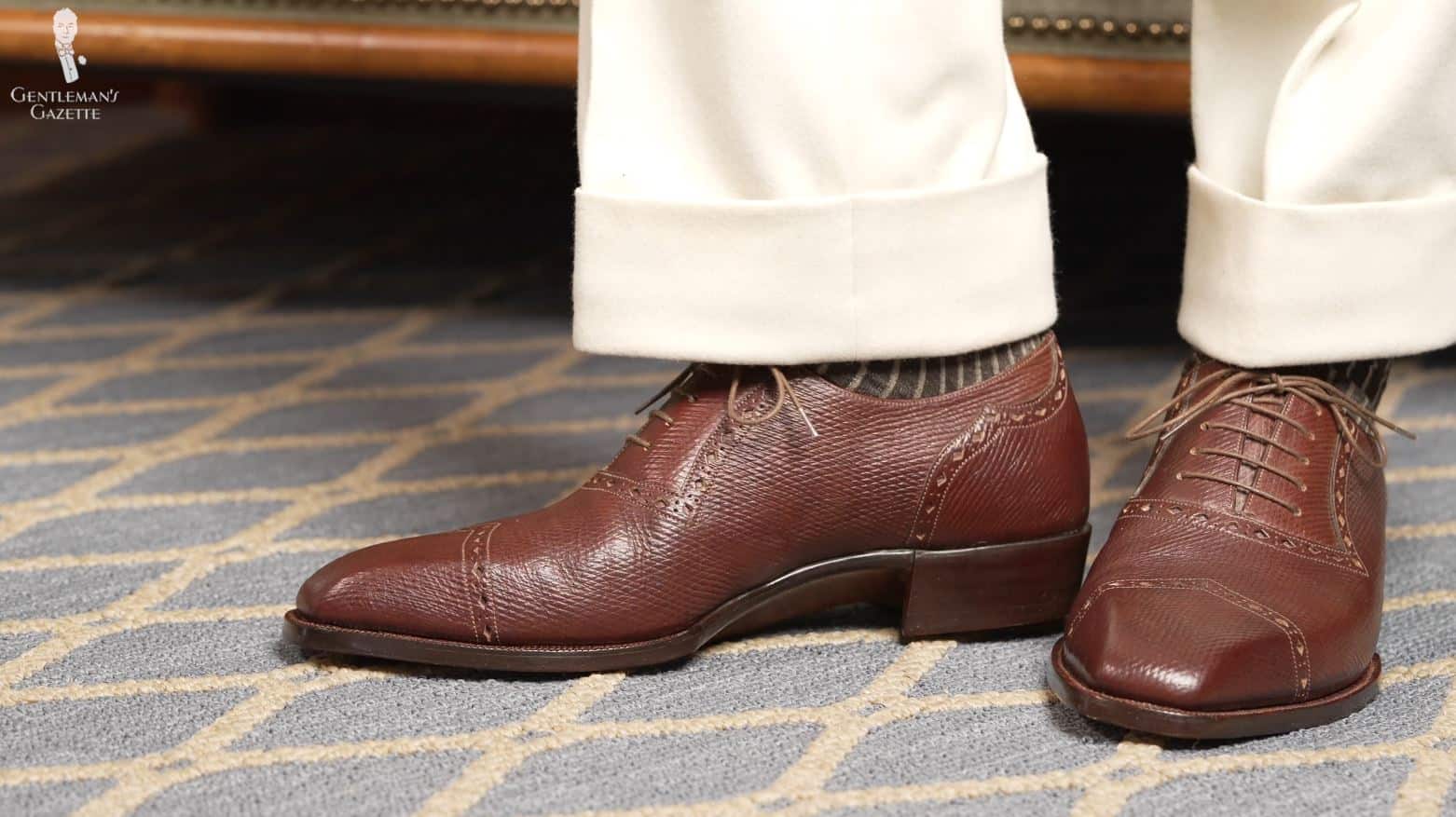
Classic dress socks most noticeably deviate from other socks in their obvious aesthetic appeal. Compared to a plain, dark grey sock or a fluffy white sock, a classic dress sock is a riot of color and style that is visually pleasing and helps set its wearer apart. Classic dress socks are available in a variety of colors and patterns that defy the boring conventions of bland socks and help make your socks an essential component of, and not an afterthought to, your personal style.
Comfort
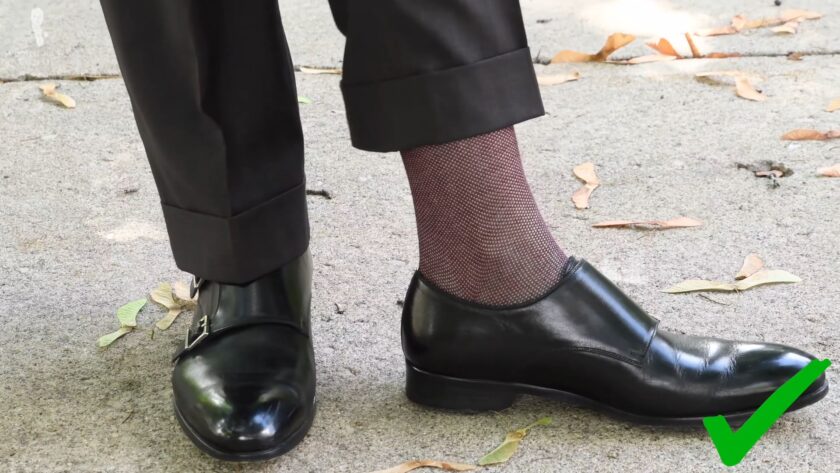
Many of the cost-saving measures that make contemporary socks cheap also make them uncomfortable. Stuffy materials, constricting elastics, and itchy fabrics make these socks a burden to wear and a nightmare for your feet. Classic dress socks, with their emphasis on quality craftsmanship and natural materials, wake you from that nightmare and usher you into a dream of soft, breathable dress socks that feel as great as they look.
Outfit Elevation
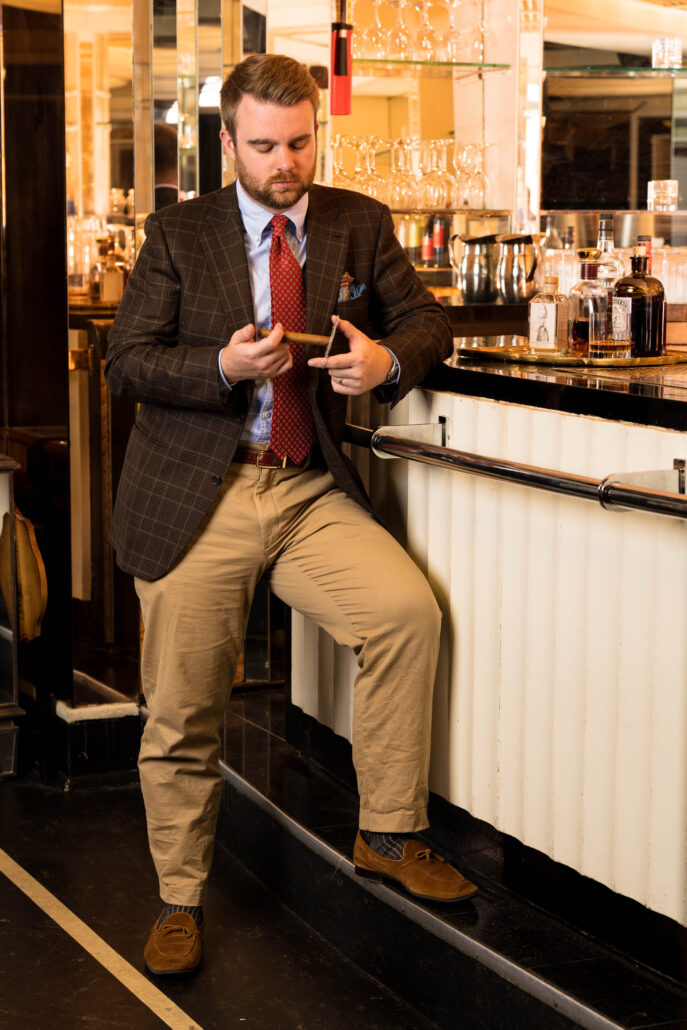

For many men, socks are a purely utilitarian article that play no role in how they craft and assemble the rest of their outfit. The result is an overall look that is mismatched and incomplete, as the small but noticeable area at the ankles is left essentially unconsidered. With their unique styling and versatility, Classic dress socks can be effortlessly integrated into any ensemble, creating a cohesive whole that helps every aspect of your outfit shine and offering an effect that is far greater than the sum of its parts.
Use Your Socks To Draw Out Colors in the Rest of Your Outfit
Dress socks can be employed to help any color in your look really pop, even colors found on other accessories. In the ensemble below, see how the elegant grey and Prussian blues on this pair of socks add luster to the petrol blue of the leather gloves.
The Hallmarks of Quality Dress Socks
Over-the-Calf Construction
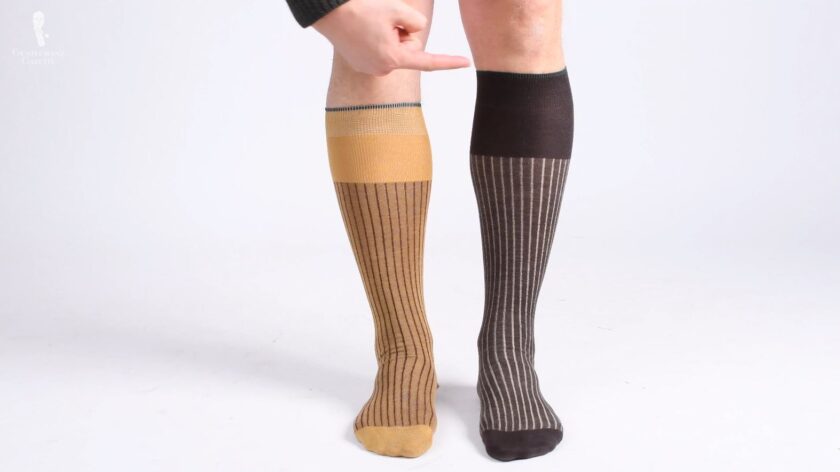
One of the most common complaints with dress socks is that they slide down. Fortunately, this issue can be easily resolved with dress socks that are designed to sit over the calf. By reaching over the calf, these socks sit securely and comfortably just under the knee, a natural flex point that helps hold the sock in place.
Shorter socks that sit on the calf, such as mid-calf socks, are jostled by the movement of the leg and are slowly worked down as you move. This flaw is innate to the construction of these inferior socks, but manufacturers do not care because shorter socks are cheaper to make. These manufacturers are content to instead make you constantly drag your socks back up as they constantly flop down.
Therefore, to ensure that your dress socks always look crisp and neat, and to save you the hassle of having to constantly pull them up, only buy dress socks that are designed to be worn over the calf.
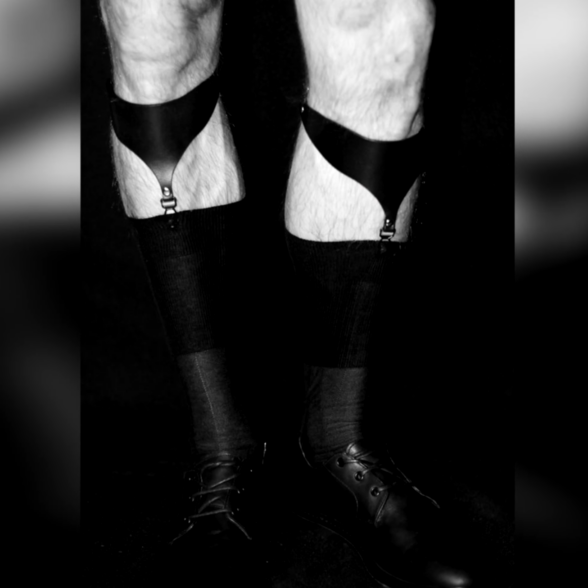
The many reasons you should avoid
Sock Garters
Following in the footsteps of the ribbons and strings that once held up hose, sock garters were one solution to saggy socks that were commonly worn well into the 20th century. Similar to a woman’s garter belt for stockings, sock garters tie around the leg and hold up socks with straps. In addition to frankly looking a little silly, sock garters have the added issues of being bulky, constricting, and often visible under your trousers, spoiling their line and overall look. We, therefore, strongly suggest that you avoid sock garters and instead invest in quality dress socks that do not require gimmicks like these.
Sizing

A one-size-fits-all approach to menswear is usually a cost-saving measure that helps manufacturers but hurts you, the consumer. This fact is especially true when dealing with socks. How a sock fits on your foot relative to the position of the heels, arch, and toes is an essential component of both comfort and support.
It also greatly impacts how well the sock stays up. If a sock is too big or too small, it will not be properly positioned on the foot and can therefore be dragged or pulled out of place. As a result, the sock will be pulled down and become saggy because it is not properly aligned.
Like a properly-sized shoe, a properly-sized sock is essential for both the comfort and functionality of the sock. Therefore, seek out sock makers who offer sized products and avoid any maker content to just offer one-size-fits-all products.
Need help battling sliding socks?
Ribbing
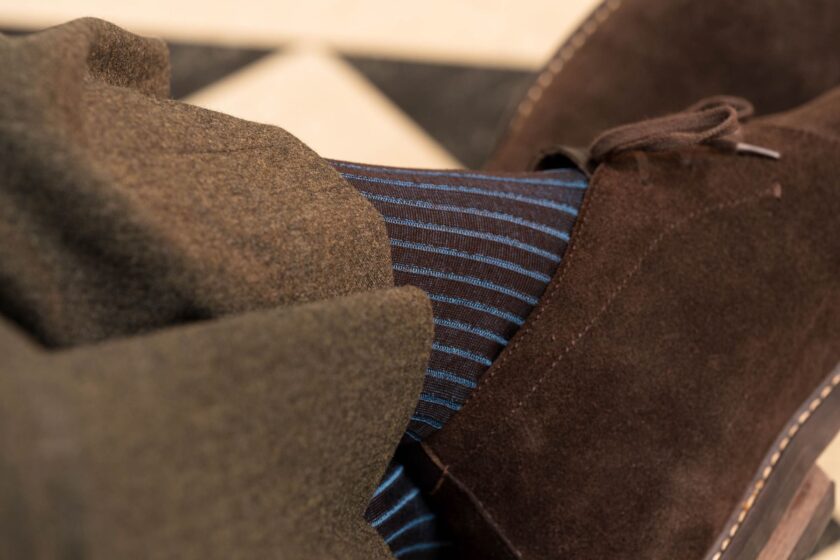
Ribbing refers to the raised bands in socks that run most noticeably along the cuff. In addition to creating unexpected texture, this ribbing also helps to make the socks more flexible and causes the fabric to better conform to the shape of your foot. Ribbed socks cost more to make than flat-knitted socks, but the results are a superior article that looks fantastic and feels incredible to wear.
Natural Fibers
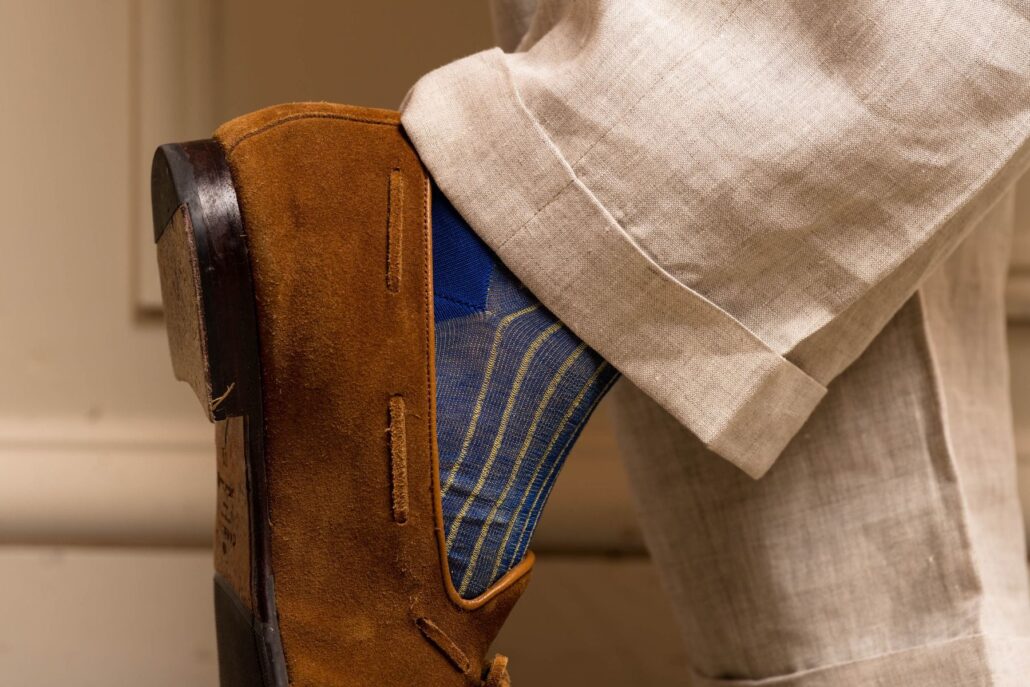

When it comes to most aspects of menswear, natural is almost always better than artificial, and this reality holds true for socks as well. Many claims are made about “performance fabrics,” but in reality, synthetic fabrics are almost always inferior to natural fabrics. Manufacturers prefer synthetics because they are cheaper, but natural fibers have superior moisture-wicking properties and are considerably more breathable, leaving your feet feeling fresher and less sweaty.
Of course, not all cotton, cashmere, or wool is alike, and for the best quality yarn, you need the longest and finest fibers. Not only will that result in a more luxurious tactile feel and touch, but the socks will also last longer and pill less than regular socks.
Note also that while extremely luxurious materials like cashmere may feel exquisitely soft, they have practical limitations. For instance, 100% cashmere socks will not stay in shape for more than a handful of washes, and they must be blended with other fibers to be useful for a while longer. They also tend to wear out more quickly than long-staple cotton socks or long fiber wool socks.
These tips are guaranteed to make your socks last longer
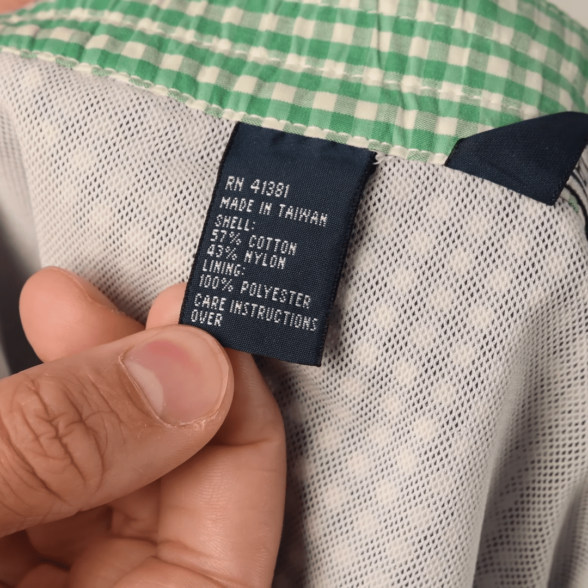
What Does it actually mean?
100% Natural
According to the industry standards of most nations, it is acceptable to label socks as being 100% natural even if there are trace amounts of synthetic materials in certain areas like the toe, heel, and cuff. Elastics in the cuff, in particular, play an important role in ensuring that the sock stays in place. Rest assured, however, that well-made socks will have the elastics shrouded by the natural fabrics, so your skin will rest against fine cotton, silk, or cashmere and not itchy nylon.
Correct Thickness

It is erroneously assumed that in order to be comfortable, a sock must be squashy and thick. In reality, however, thick socks are only really necessary in two situations: when worn as part of athletic gear that requires a certain amount of cushioning due to jostling when exercising and when worn as cold-weather gear to help keep warm. In all other circumstances, finer, thinner socks will offer a superior wearing experience, as they will have better breathability and lay pleasantly against your skin.
Thinner, more refined socks also have the added benefit of appearing far more elegant, as they will not look bulky or heavy like thicker socks.
Smooth Closure at Toe Area
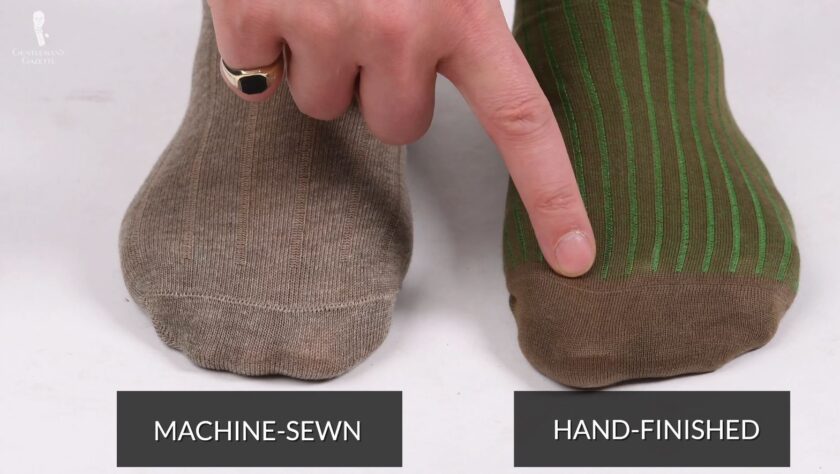
Most modern socks are machine-knitted, but most machines cannot link the toe area neatly, necessitating a seam to close the socks. When laid in by a machine, this seam is often bulky and thick, creating a ridge that will rub against and irritate your foot.
There are special machines that can link toes with a flat seam that is less irritating, but these machines are often very expensive and are not often used. Therefore, most high-quality dress socks are finished by hand, allowing the sewer to determine how to close them without leaving an unpleasant seam at the toe.
All Fort Belvedere socks are hand-linked by dedicated artisans!
Stylish Design Choices
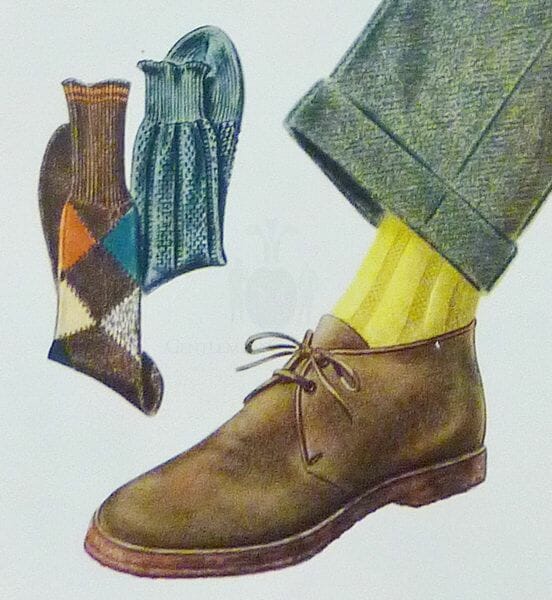
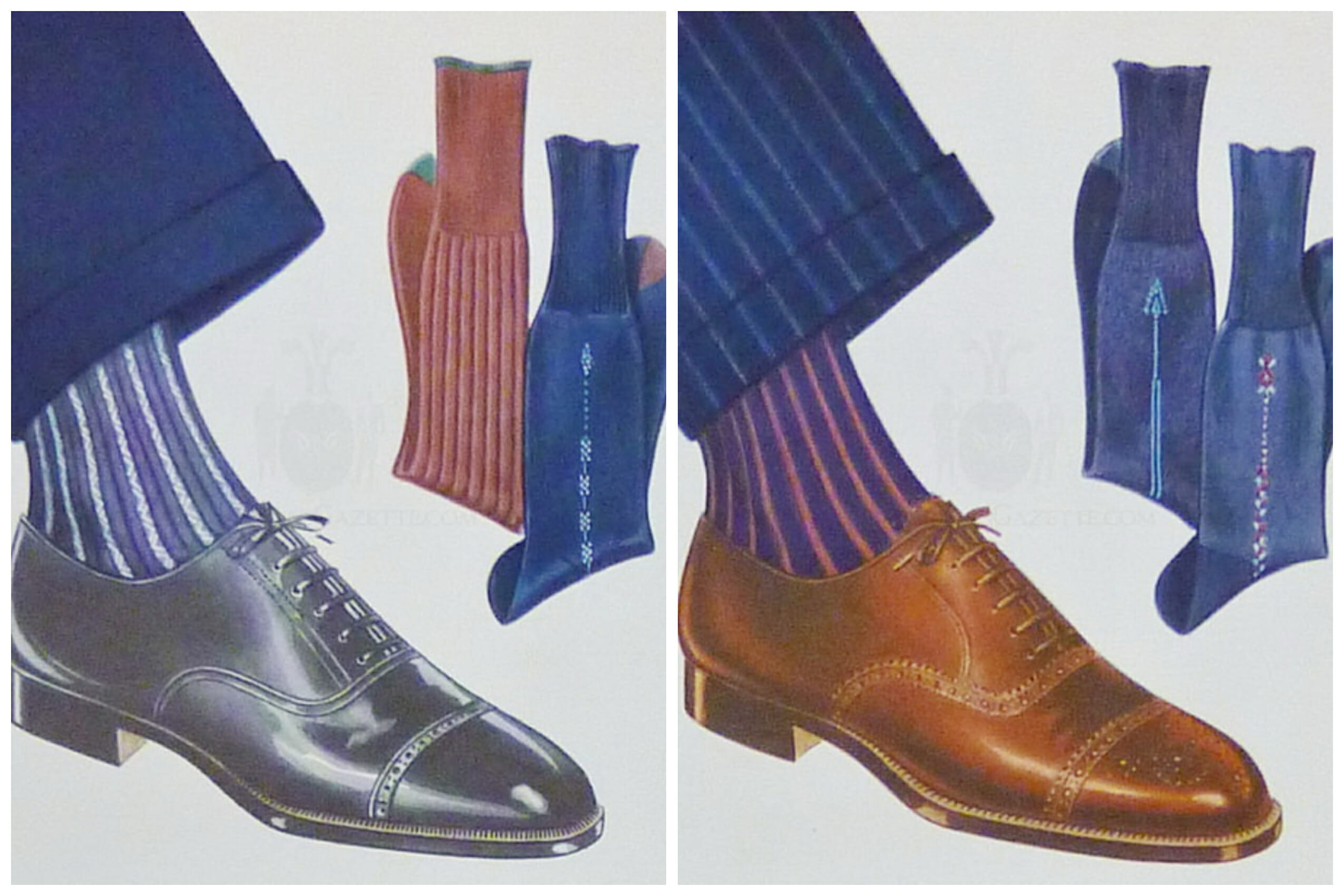
The contemporary state of men’s dress socks leaves much to be desired. Socks either tend to be bland and boring or outrageous and distracting. Fortunately, a few makers still keep to the sartorial traditions that made the dress socks of the Golden Age of Menswear the best in history, emphasizing the three following style choices.

Colors
During the Golden Age of Menswear, socks were available in a variety of colors. In addition to darker hues to fit more formal occasions, there were also vibrant and fun colors like orange, green, yellow, and pink. These colors helped to enliven and unite outfits and made it possible to dress to the various dress code standards that Classic Style encompasses: you don’t spend all of your life at the office, so dress socks should be not restricted to extremely formaj colors like black, charcoal, and dark brown.
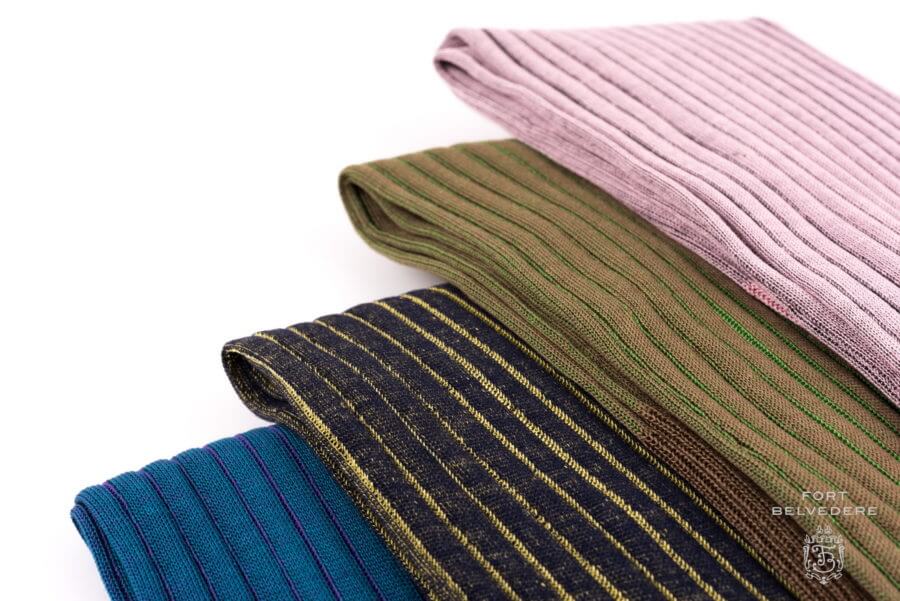
Patterns
In both casual and formal dress socks, patterns are an essential way to introduce unexpected visual interest and create a unique appearance.
One of the most common patterns in Classic dress socks is stripes, which double the number of colors present in the socks and provide more opportunities for contrasting or complementing socks with the rest of the outfit.
To achieve a similar effect, socks were also made in a two-tone weave. This alternating weave, in which two colors of yarn are used, introduces two unique colors but in a subtle, amorphous way that, at a distance, can seem to resolve into just one solid color. Two-tone socks are a great option for adding color in a sedate fashion.
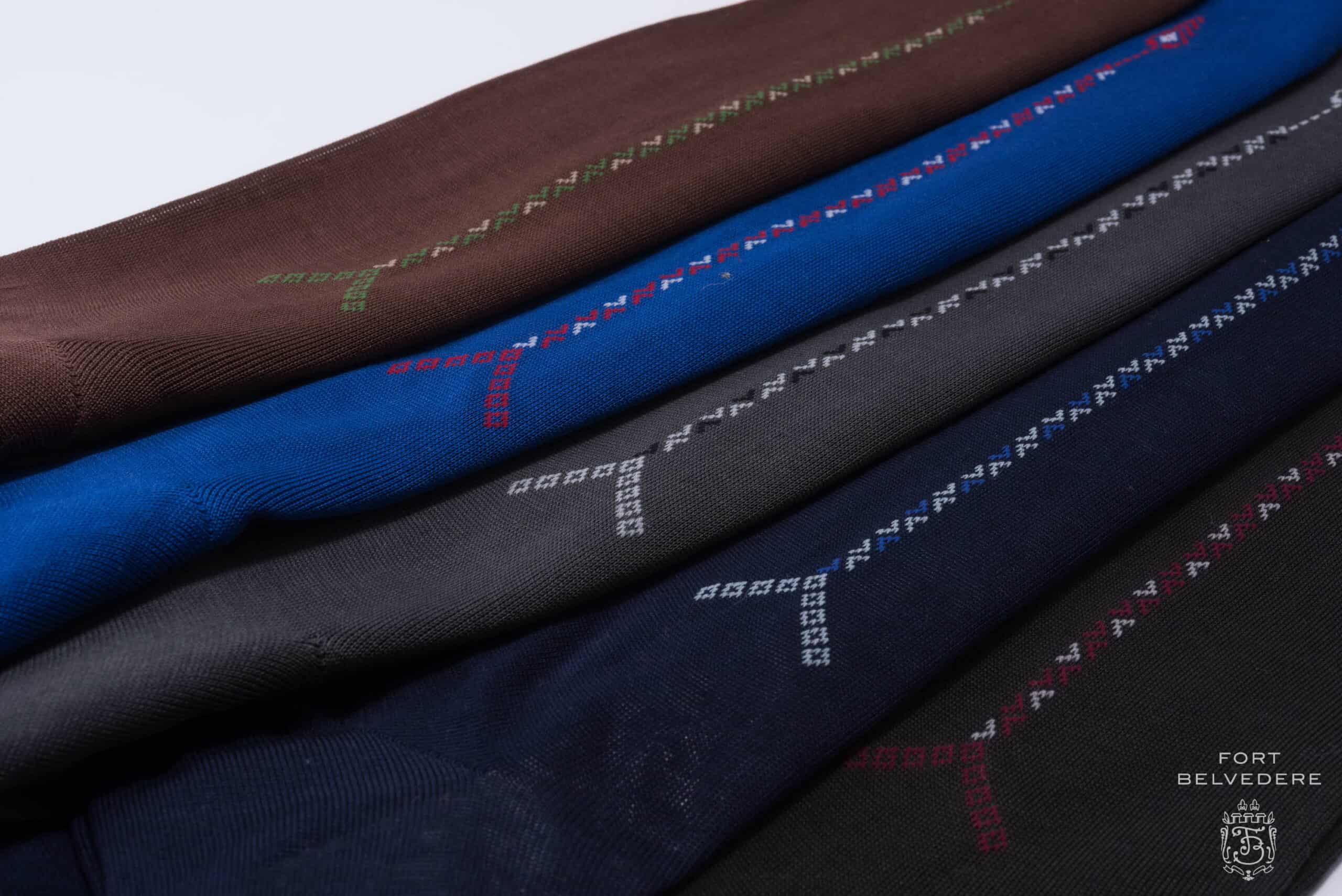
Clocks
Clocks, or clocking, refers to a chevron and diamond geometric pattern that often decorated the cuff of socks during the Golden Age of Menswear. This subtle pattern injected color and strong visual lines but in an unobtrusive and subtle way. Clocks are, therefore, one of the most versatile ways to add color to socks, as they are very discreet and, therefore, more formal but also memorable and interesting.
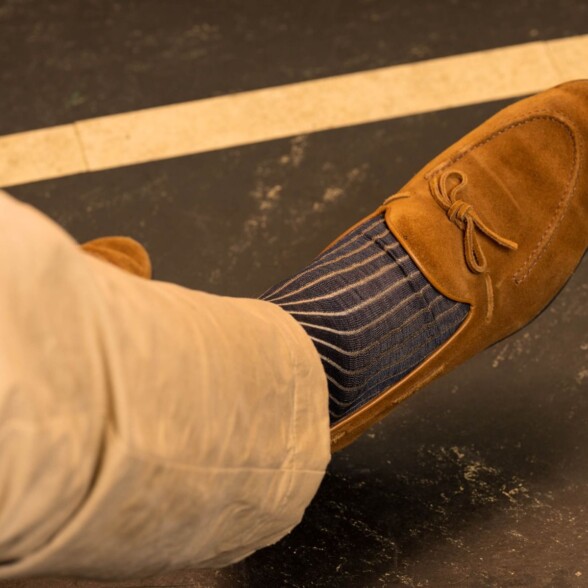
Dress them up or dress them down
Sock Colors
When selecting sock colors, especially for patterned socks, you will gain the greatest versatility by opting for combinations of formal and informal colors. In this example of navy socks with khaki stripes from Fort Belvedere, the navy body grounds the socks while the khaki brightens them up. The contrasting colors can be used to pick up various shades in the rest of the outfit, allowing you to shift your color palette to perfectly achieve the desired level of formality.
Stop the clock with exceptional and colorful clocks!
Common Sock Materials
| Material | Notes |
|---|---|
| Cotton | Cotton tends to be extremely light and breathable and is, therefore, one of the best “all-around” sock materials, especially when made from quality cotton, such as Fil d’Ecosse. What cotton socks lack in endurance, they more than makeup for in breathability. |
| Wool | Wool is a durable, insulating material that has been a preferred sock-making material for centuries. Wool socks are ideal for colder weather and can survive heavier use, but this sometimes comes at the cost of being thicker and bulkier. Finer wools, like merino wool, can mitigate this issue. |
| Silk | Silk has been the preferred fabric for luxurious socks for millennia, and to this day, silk is still the ideal material for the most formal and the most elegant socks. Silk is, however, very fragile and very costly, and as such silk socks must be treated as the precious articles that they are, and they are relatively easy to damage. |
| Cashmere | One of the most expensive fabrics in the world, cashmere is a luxurious material that imparts a uniquely soft and sublimely insulating feel to socks. In addition to being very expensive, however, cashmere is delicate, and pure cashmere socks often become lank after regular washing. |
| Synthetics | Socks can be made from a variety of synthetic materials, with nylon being one of the most famous. But the fact of the matter is, while nylon may be cheap, durable, and thin, it is also extremely stuffy and does not have the elegant sheen of finer materials. |
| Blends | Any of the previous materials can also be mixed together in various ratios to create blended socks. On many occasions, especially when natural fibers are mingled, blended dress socks can offer the best of both worlds, combining the qualities of different types of materials in one pair of socks. |
Learn the 7 Essential Sock Types!
How To Elegantly Combine Socks, Shoes, and Trousers
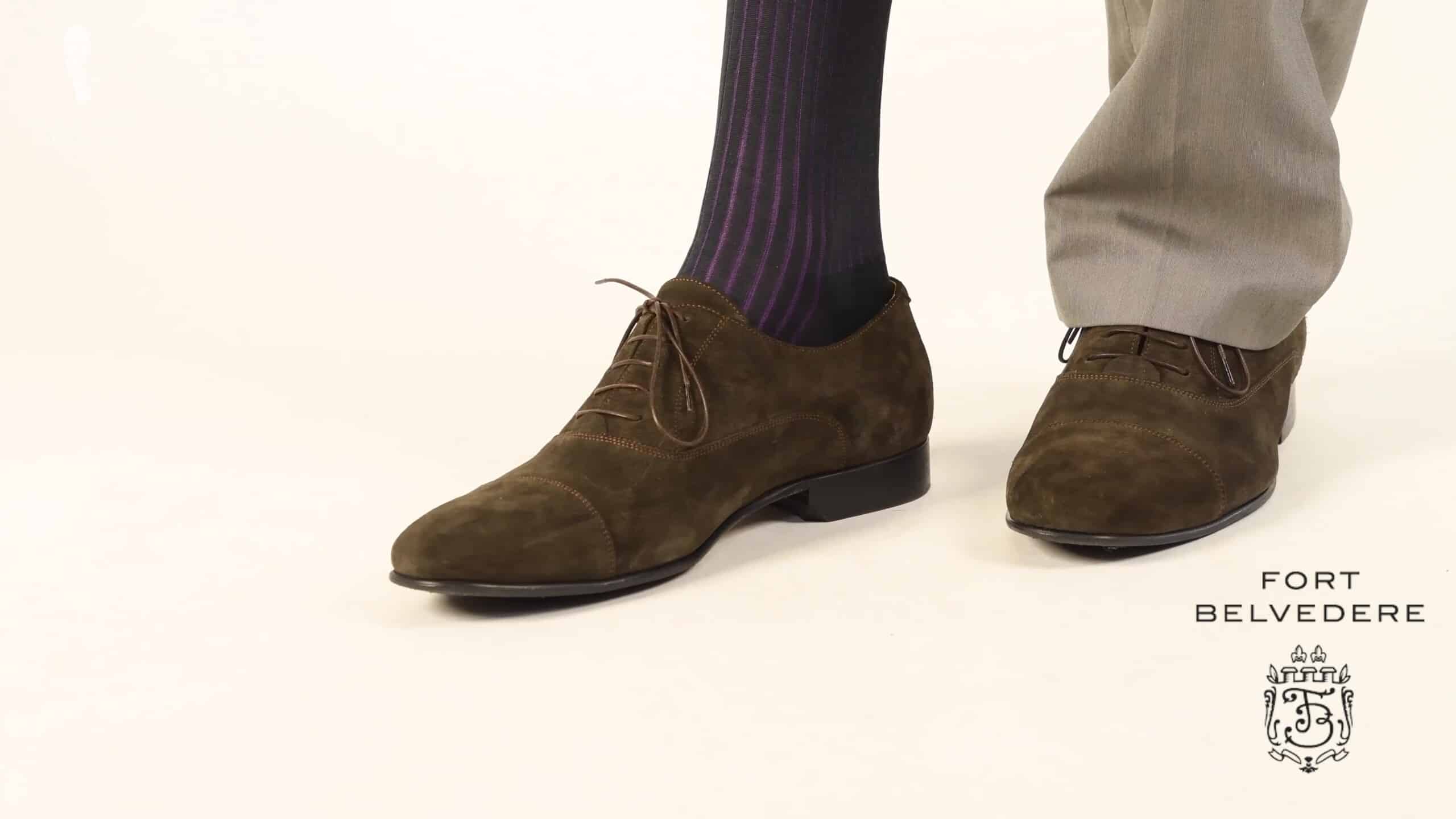


There is an art to elegantly combining all aspects of your outfit, and one of the most difficult combinations involves integrating your dress socks into your entire look. Fortunately, this issue can be resolved with a basic grasp of color theory and knowledge of a few simple rules.
- Match socks to your trousers, not your shoes. Many men attempt to match their shoes and socks, but the result is a muddy mess that dims the color and pop of both articles. If you’re going to match your socks to another wardrobe element (and as we hope we’ve shown, you don’t always have to!), match them to your trousers–in so doing, you create a unified whole that helps to bridge the gap between your shoes and the lower half of your ensemble.
- Don’t forget the rest of your outfit. While their proximity makes it most important for your socks and trousers to suit each other, do not forget the other components of your outfit. Using your socks to pick out colors that appear elsewhere will make it clear that you assembled your look with a complete vision in mind, ensuring that your outfit looks outstanding. For instance, if you are wearing a grey jacket, consider featuring a grey element like stripes in your socks to link these two garments together.
“The Golden Rule of sock-matching is to always match them with your trousers, not your shoes.”
Raphael Schneider
- Complement or contrast, don’t copy. Unless you’re wearing black shoes, socks, and trousers, as in a formal outfit, it is unlikely that you will be able to perfectly match the shade of your socks to your trousers. If the colors of these two garments are too similar without being the same, the effect will be unpleasant and weird, giving the impression that something just isn’t right. Therefore, rather than trying to exactly copy the colors, you should pair socks and trousers that have complementary or contrasting colors. This will unite the shades and create a pleasing whole.
- Employ patterns to highlight more colors. When it comes to both contrasting and uniting your outfit, few style choices work better in socks than patterns. Patterns create defined shapes that help break up the monotony of solid colors, and patterns can introduce additional colors to pick up other colors in the rest of your outfit.
Common Color Pairings
The following examples will showcase explicitly the wide range of dress socks that can be effortlessly paired with three of the most common colors in menswear: blue, grey, and brown.
Socks that Pair with Blue
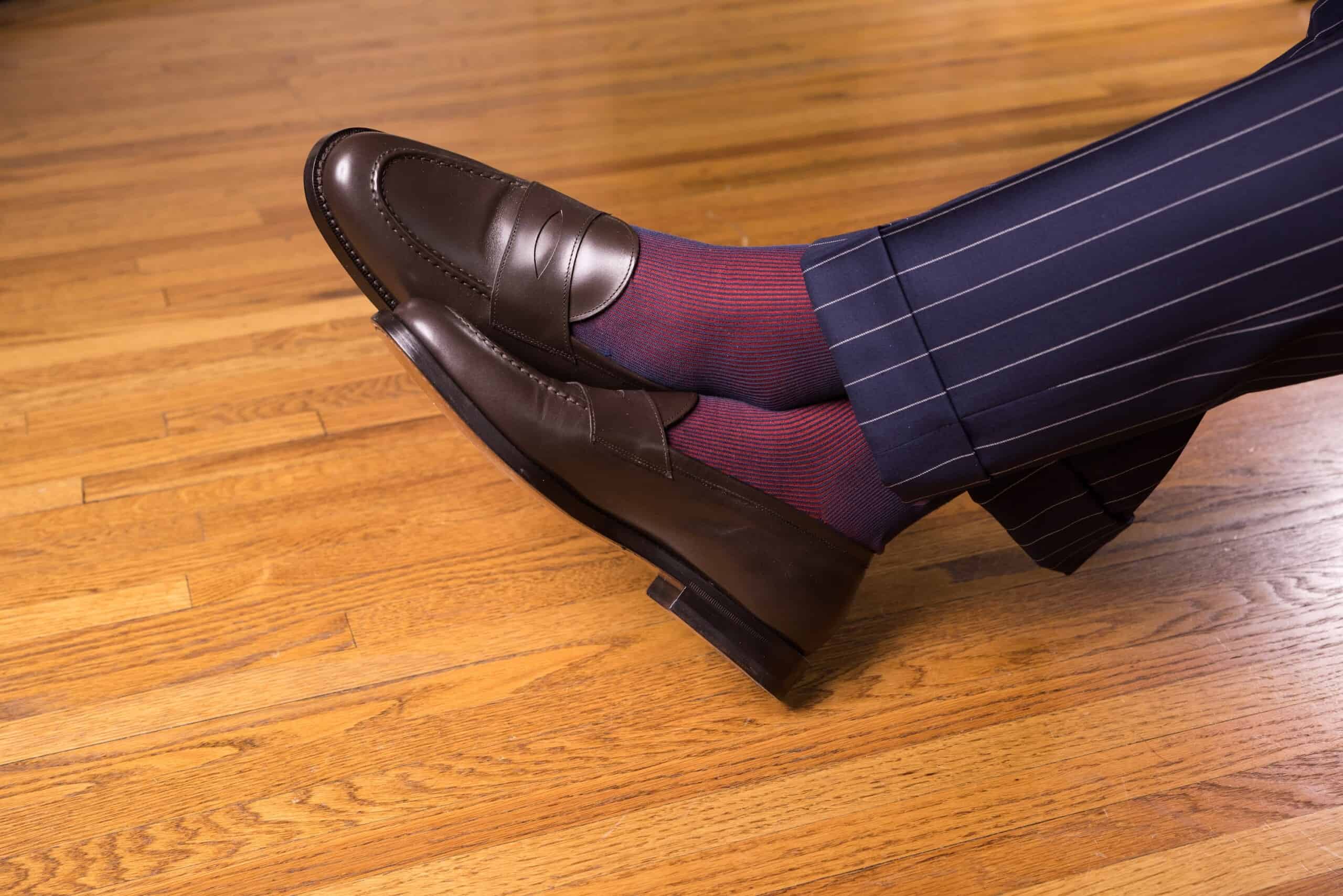
Dark Blue & Red Two-Tone Solids
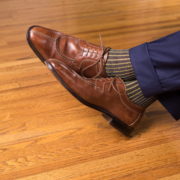
Navy and Yellow Stripes
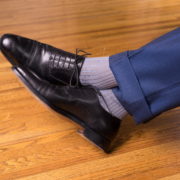
Light Grey & Light Blue Stripes
Socks that Pair with Grey
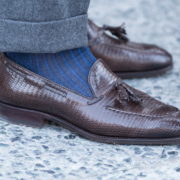
Dark Blue & Royal Blue Stripes
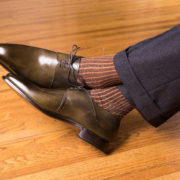
Charcoal and Orange Stripes
Grey Blue & Prussian Blue Two-Tone Solids
Socks that Pair with Brown

Navy & Yellow Stripes

Dark Green & Purple Stripes

Dark Grey with Burgundy & White Clocks
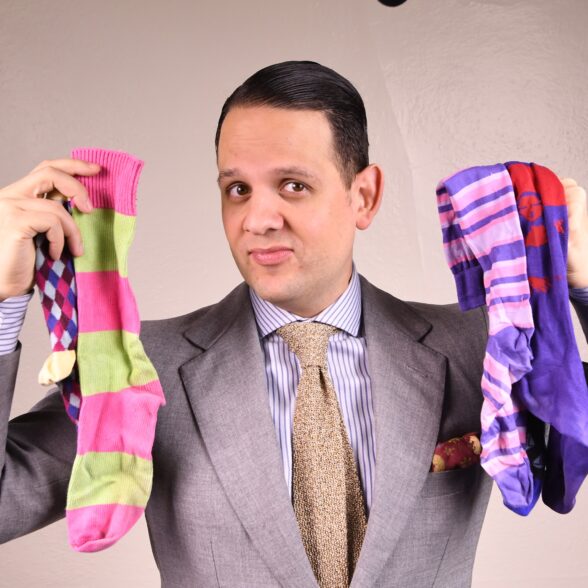
Should you wear
Crazy Socks?
Since the mid-20th century, extreme novelty socks, also called Crazy Socks, have become increasingly common. You can find them in nearly every color under the sun, and sometimes they have comical or serious motifs. It is commonly assumed that Crazy Socks are indicative of spontaneity and creativity, but in reality, they often come off as juvenile. In our opinion, you will be better served to wear bold, colorful Classic dress socks rather than obtrusive Crazy Socks.
Learn more about Crazy Socks
The Right Socks for the Right Shoe
Certain types of shoes are especially well-suited to certain types of socks. Usually, this occurs because the socks and shoes share a common functionality or formality, creating something of a match made in heaven. The following pairing suggestions are not necessarily hard-and-fast rules, but they do illustrate the particular ways that certain types of shoes pair well with certain types of socks.
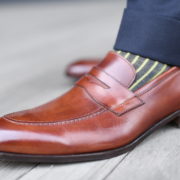
With Loafers … Consider a Colorful Striped Sock
As a generally more casual shoe, it would make sense that loafers pair well with generally more casual socks. Casual socks are often more colorful, and the open throat of a loafer helps to showcase those fun and unique colors. Accordingly, stripes are a great option with loafers, as they will allow you to coordinate even more colors within your larger ensemble.

With Oxfords … Consider Sedate Socks with Clocks
Oxfords are the king of day shoes, and as such are often worn with business ensembles. This added formality should be reflected in the socks, and so, when you are dressing up a pair of oxford shoes, you should draw from a darker color palette for your socks. A hint of color, however, can prevent your lower half from appearing too drab, which is why clocks are a perfect option. They add visual intest, but in a subtle way.
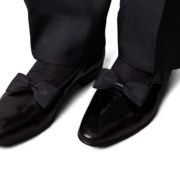
With Formal Pumps … It's Got To Be Evening Socks
Our final example is something of an outlier because it is not a suggestion, and is instead a rule. If you are wearing the most formal men’s shoe, the opera pump, it should usually be paired with the most formal men’s socks, formal evening socks. These delicately fine, elegantly shimmering socks are the perfect complement to any Black or White Tie ensemble, especially when worn with a pair of opera pumps that really put these gorgeous socks on display.
Don’t forget shoelaces!
Shoelaces also play a considerable role in ensuring an organic transition between the color and texture elements of your socks, shoes, and trousers. In fact, shoelaces are one of the most cost-effective ways to effortlessly change the look of your shoes. Therefore, always keep your shoelaces in mind when you are crafting the look of your accessories around your feet.
Want More Information on Combining Socks, Shoes, and Trousers?
Check out our Free eBook!
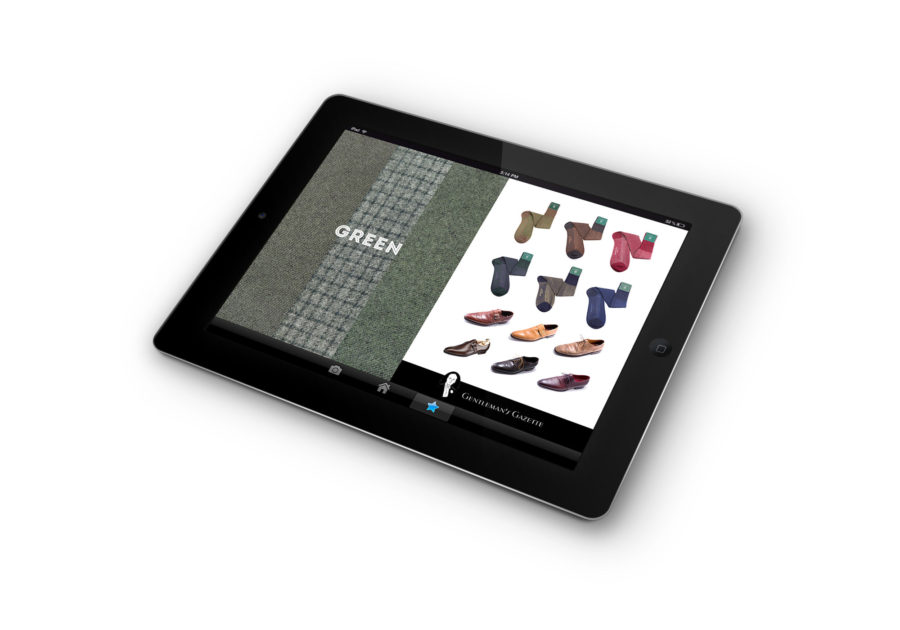
Get the eBook for free!
The Benefits of a Sizable Sock Drawer
Increased Versatility
Relative to many other accessories in Classic Menswear, high-quality dress socks are relatively inexpensive, especially as they offer a superior cost-per-wear ratio. Therefore, it will behoove you to acquire a sizable number of dress socks to ensure that you have access to a versatile stable of options that will help to elevate a wide variety of ensembles: aim for eventually having a collection of at least twelve pairs of dress socks.
Improved Durability
Having a larger number of dress socks will also allow you to rotate your selections so that you do not overwear any one pair of socks. Excessive wear, especially within a relatively short time frame, can cause friction damage that wears holes in socks. By spreading out the times that a sock is worn by cycling in other socks, you help to ensure the longevity of all of the socks in your collection.
Buy in Bulk and Save with Fort Belvedere!

How to Store and Organize Socks
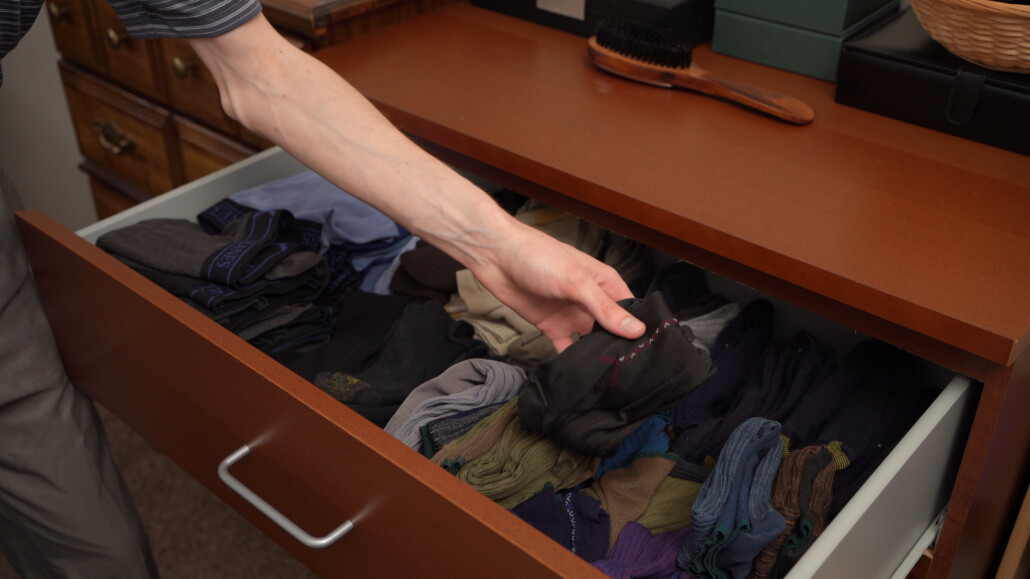
Do not let your sock drawer devolve into an untidy mess! A carefully organized, well-maintained sock drawer will allow you to easily access your socks, facilitating the outfit-assembly process, and will prevent your socks from becoming excessively crumpled or musty. Employ these tips to ensure that you get the very best from your sock drawer.
- Spread socks out in neat rows! Doing so will allow you to see your entire collection in one glance and will help to utilize limited storage space effectively. It will also make every aspect of properly utilizing your socks that much easier.
- Arrange socks by type! There are many different kinds of socks, each suited to different functions. Keeping your gym socks in one area and your dress socks in another area, even if it is just corners of your drawer, will make it that much easier to find the correct socks that you need.
- Loosely group socks! Arranging socks by colors or patterns will make it easier to find contrasting and complementary colors that help your socks match the rest of your outfit. Organizing your socks in this way will encourage you to think creatively when selecting socks, contributing to better-looking outfits overall.
- Fold or tie socks! Eventually, even the quality elastics of well-made dress socks will start to degrade with wear. Reduce the wear on elastics by loosely tying or folding socks rather than rolling them into each other.
- Rotate regularly! The constant force of repetitious friction from rubbing against your shoe can wear holes in even the best-quality socks. Avoid overwearing any single pair by having access to a large collection of versatile, well-made dress socks.
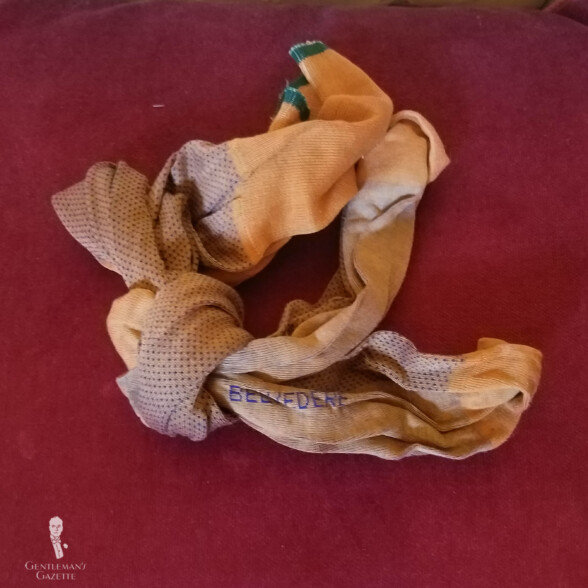
Knot or fold your dress socks and
Reduce Rolling
In an effort to efficiently keep paired socks together, many people will roll one sock into the other. Doing so, however, puts constant stress on the elastic in the cuff, which causes the elastic to break down more quickly and lose its spring. Therefore, to help your socks last considerably longer, you should either tie them in a loose knot or fold them together.
Dress Sock Buying Guide
In menswear today, there are a wide variety of companies offering men’s dress socks. These include famous luxury houses, artisanal accessory makers, and even companies that only make socks. The right sock maker for you can depend heavily on your personal circumstances, but in general, you will get what you pay for with dress socks, so it often makes sense to invest in genuine quality.
The following brands have been selected for your consideration because they offer a variety of dress sock choices and several different price points.
| Brand | Notes | Price (2022) |
|---|---|---|
| Gold Toe | Traditional American brand known for a basic but dependable sock selection. | Approx. $8 per sock |
| Happy Socks | Specializing in dramatic “crazy socks,” Happy Socks does offer a few patterns that, while very bold, can still work within Classic Style. | Approx. $16 per sock |
| Stance | With both unique and standard designs, Stance dress socks put a strong emphasis on performance fabrics. | Approx. $20 per sock |
| Bombas | Emphasizing comfort, Bombas dress socks come in a variety of colors with some options for unique designs. | Approx. $22 per sock |
| Brooks Brothers | An iconic name in preppy American menswear, Brooks Brothers offers basic socks in a range of formalities. | Approx. $25 per sock |
| Marcoliani | Made in Italy and clearly focusing on dramatic, colorful Italian styling, Marcoliani socks always add a dash of the unexpected. | Approx. $32 per sock |
| Pantherella | Sock offers from English sock-maker Pantherella run the gamut from very sedate, dark business socks to wonderfully colorful, festive socks. | Approx. $35 per sock |
| Fort Belvedere | With a focus on classic styling and artisanal quality, Fort Belvedere aspires to offer a well-made, Classic dress sock for every occasion. | Approx. $40 per sock |
| John Lobb | From one of the leading names in footwear comes a collection of socks that, while simple in design, are made with quality materials. | Approx. $80 per sock |
You Get What You Pay For!
Learn what distinguishes a $40 pair of socks from a $4 pair in this video!
The Do’s and Don’ts of Dress Socks
The Do’s and Don’ts of Dress Socks

Don't wear damaged socks
Rips or punctures in socks not only look bad, they get worse with every wear. So have your damaged socks darned or throw them out and get a new pair.
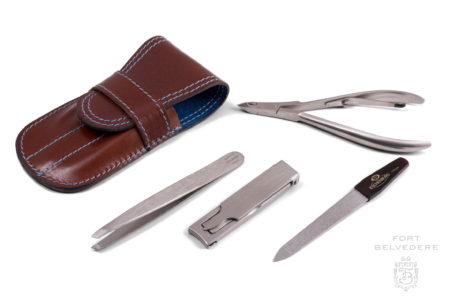
Do trim nails and treat your heels
Sharp, jagged toenails can catch on your socks, potentially damaging both the sock and the nail. Likewise, rough skin on your heels can wear through socks more quickly. Taking care of your feet is a great way to also take care of your quality dress socks.
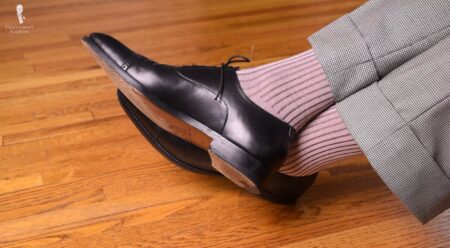
Don't wear bold and bright socks with formal wear
Formal dress codes like Black and White Tie call for formal socks, which should be dark and usually have a very plain design. Save your colorful socks for more casual events.
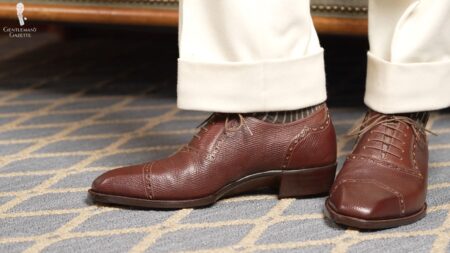
Do match your socks to your outfit
A perfectly coordinated pair of socks will make any outfit appear ten times better, because well-matched socks indicate a sense of style and dedication to attention that help make your entire ensemble look like a cohesive whole.
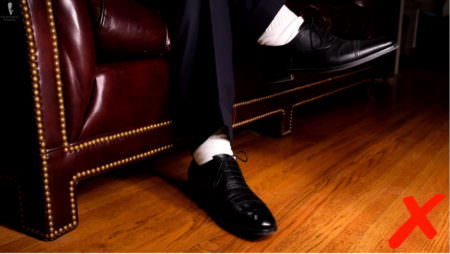
Don't wear athletics socks with business or formal attire
While they may be comfortable, heavily-padded, white gym socks are designed for one place: the gym. Never wear them with business or formal outfits because their thick texture and white color is far too casual for those more formal events. Save socks like these, including crew socks, for sneakers.
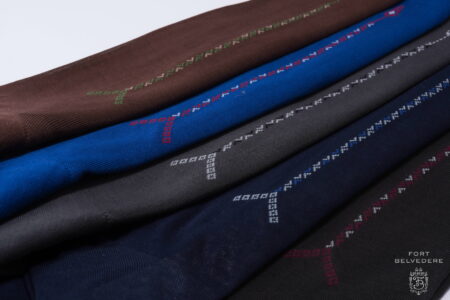
Do invest in quality
While it may be tempting to skimp on socks, because they are mostly covered by your shoes and trouser legs, quality socks will not only help you feel your best, but also look your best. Investing in a good pair pays considerable dividends in style, wear-ability, and versatility.
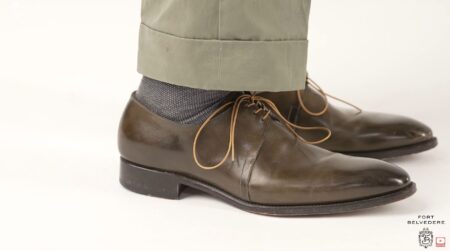
Don't overwear socks
If you find a pair of socks that you love and that work with many outfits, resist the urge to constantly wear them. Wearing one pair of socks too often leads to increased damage from wear-and-tear. Instead, maintain a diverse collection of socks so that you can rotate each pair, extending the life of every sock.
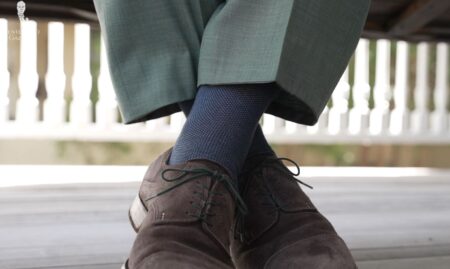
Do keep socks in pairs
Socks are sold as matched pairs because they are meant to be worn as matched pairs. Therefore, do not mix and match socks in an effort to be creative: the effect will just be jarring and distracting. Also, be aware that even black socks have subtle variations in shades, so be extra attentive to keeping socks paired correctly when washing.
Do your socks and your feet a favor with a quality nail kit!
Conclusion

Dress socks may not be the first thing that people notice about your outfit, but they are a literal foundation accessory that serves to both ground and enliven every other aspect of your look. We, therefore, hope that this guide has been helpful in detailing how you can get the very best from your dress socks, ensuring that they are a critical component of your look and not an oft-forgotten afterthought.
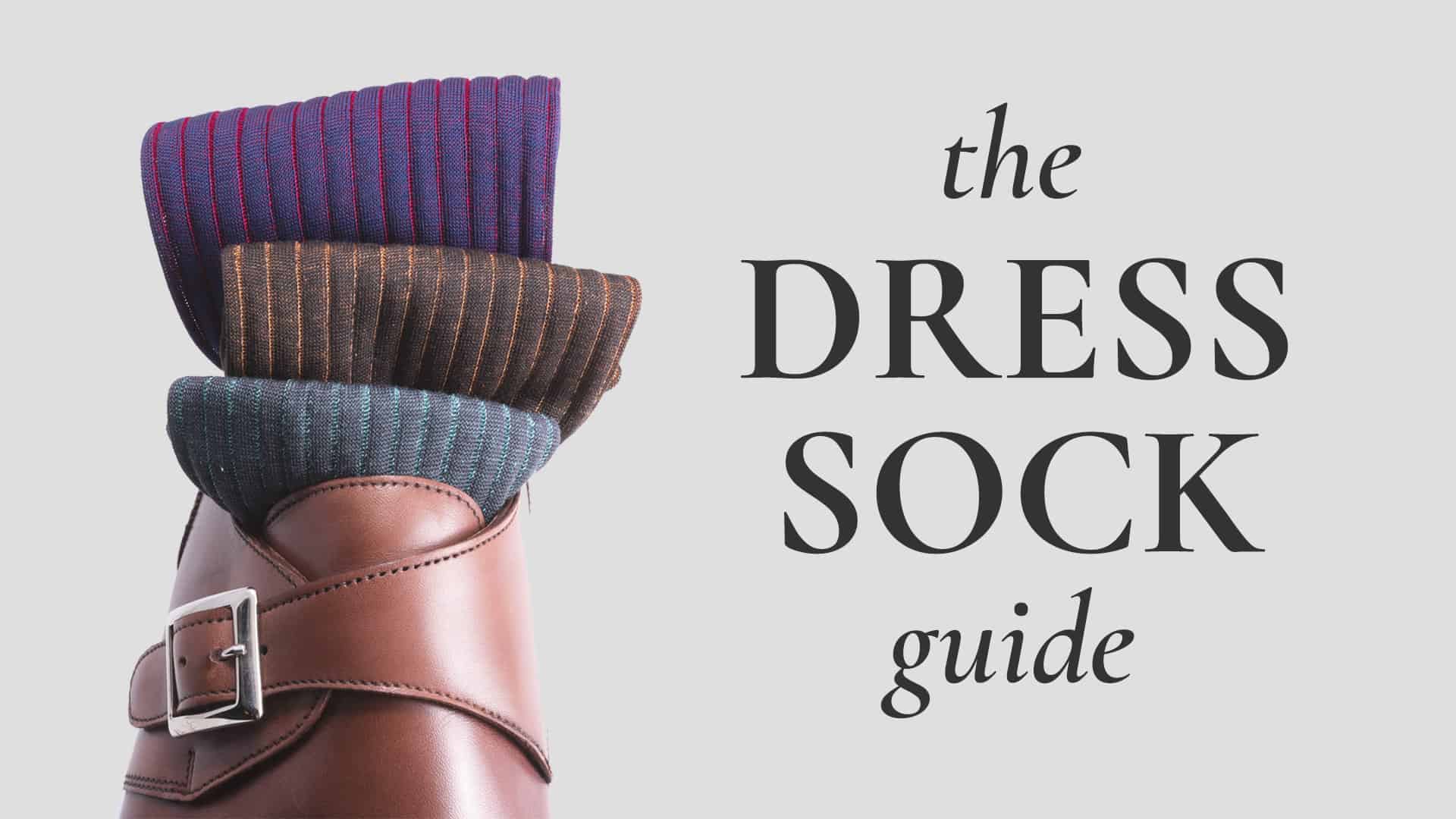

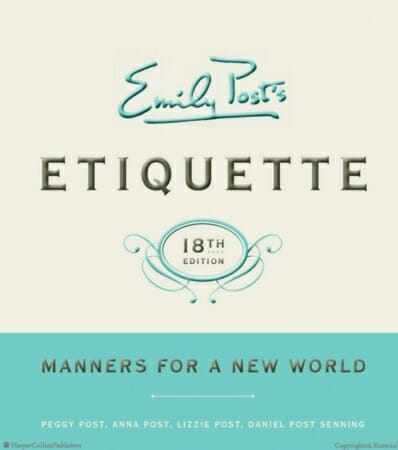
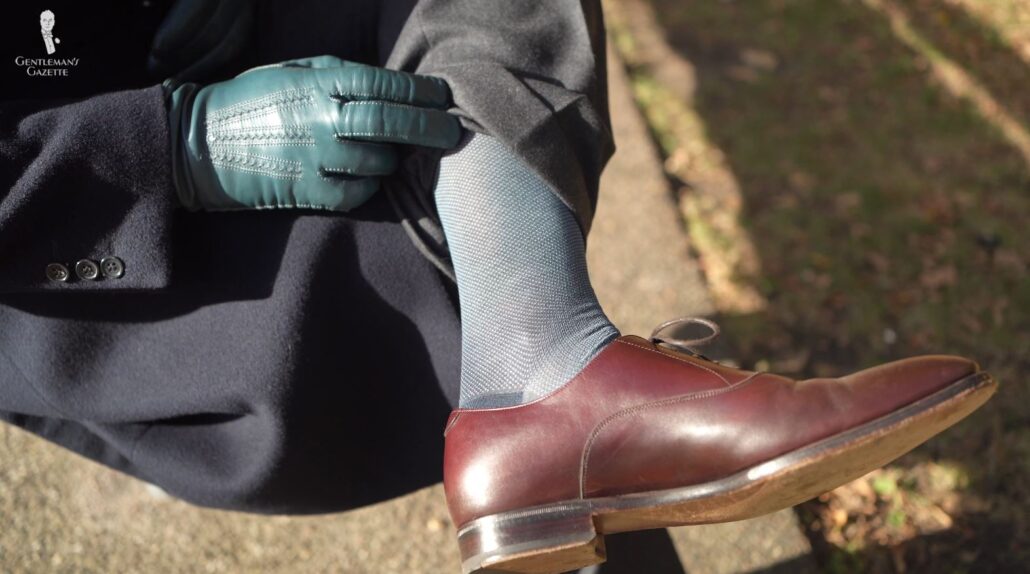
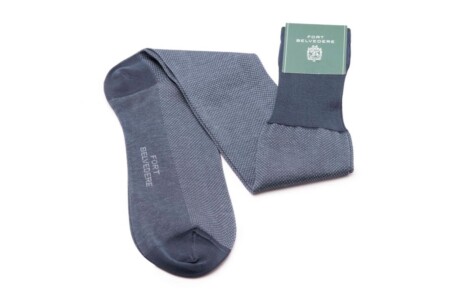
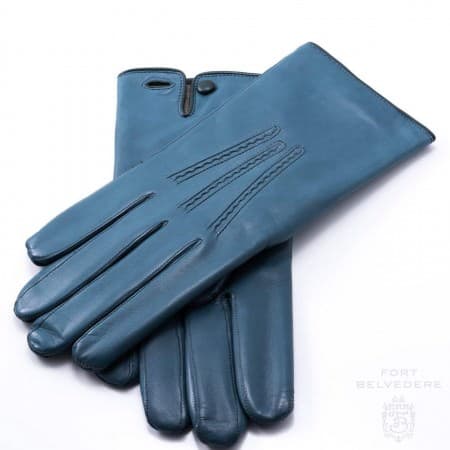
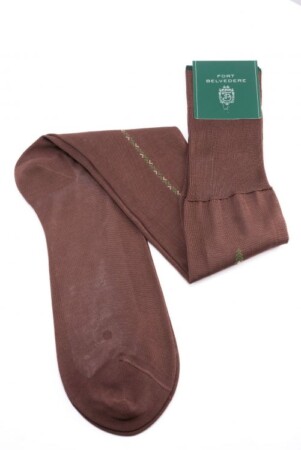
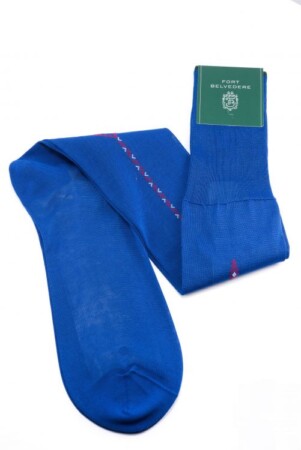
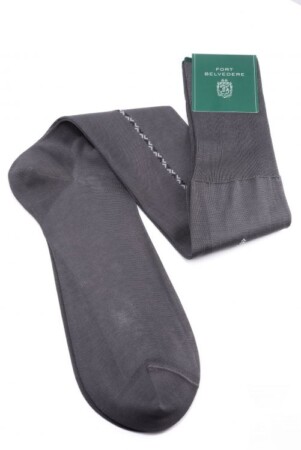
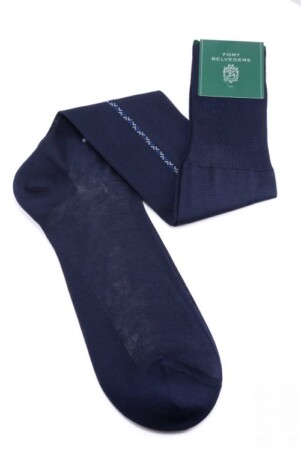
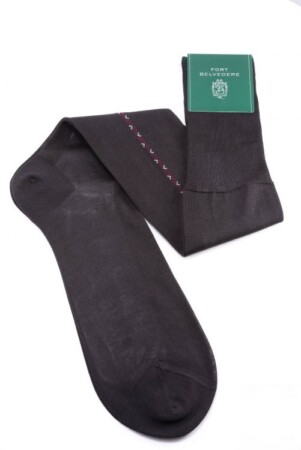
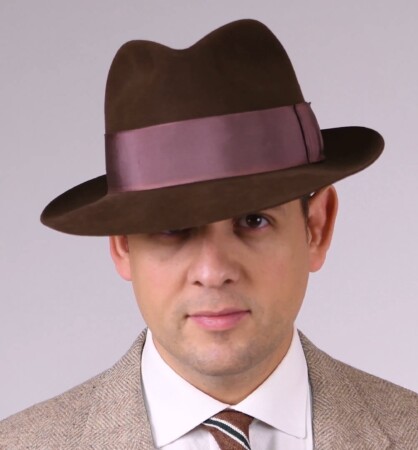
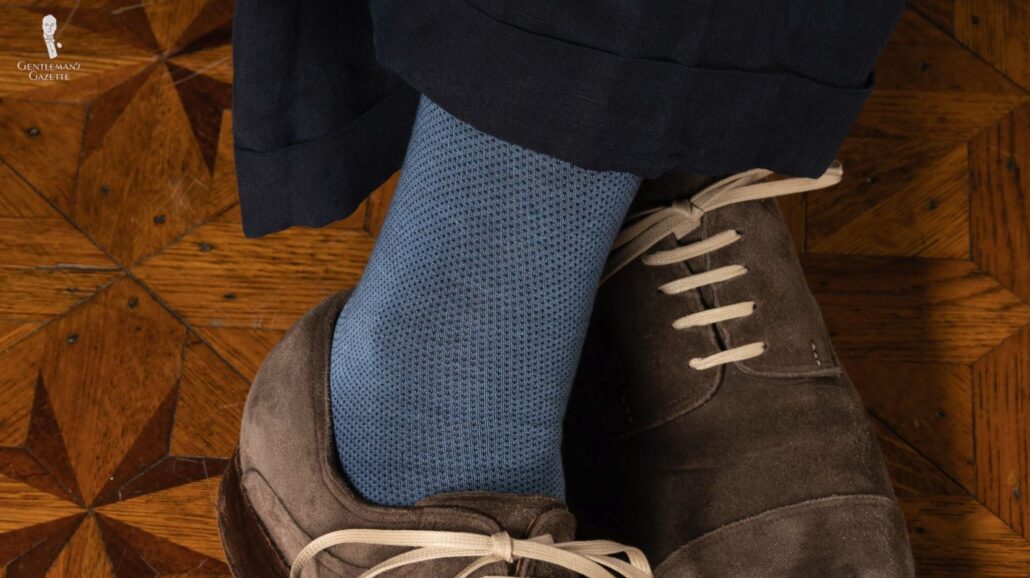
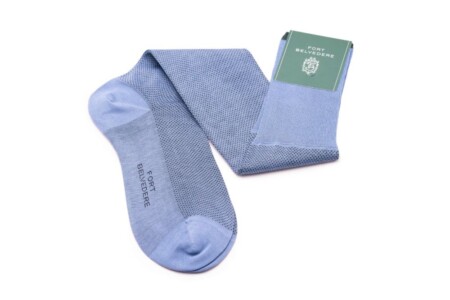
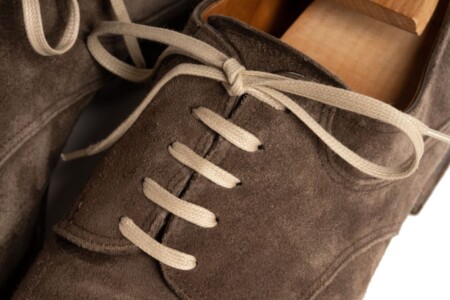

Very informative piece of history and advice. However, while I understand that you often discourage “sock suspenders”, the image that you show above is actually the one of shirt stays, despite that both can serve a common purpose of keeping the socks up (which is the part you don’t recommend) and the shirt tucked in. As for the latter, I still think its use is well justified to keep the shirt from forming a muffin top above the waist during the day, even with properly fitted shirts, when you sit and stand, bend and extend. For this reason I believe these are still very much used in the military (I am deferring on this one to Antonio Centeno). Lastly, speaking from my personal experience, any time I dress up, especially for a festive occasion, by putting on the shirt stays and suspenders I feel like I can safely forget about how I look and focus on what I am doing, and still look like a million dollars.
Of course were are familiar with the other sock suspenders on the calf etc. but I find them just as useless. Antonio did use them, but I showed him that they were not necessary.
You can look like a million bucks without shirt holders or shirt suspenders every day. There is zero reason to use them, unless of course, your socks are too short or the shirt does not fit right.
I would not be caught dead wearing these things for festive occasions especially since they show through and look anything other than a million bucks. But if they make you feel better, go for it.
Raphael, since you do not recommend shirt stays I would actually like to know what you recommend to keep your shirt from untucking. I agree that shirt stays and sock garters are not a comfortable solution for these things and have a genuine curiosity how you remedy this issue. I appreciate your information on this subject. Thank you.
Quentin,
As a cadet at Texas A&M, we used an elastic baseball belt that would sit along your hips, reaching back to hold down your shirt tail. Trousers would go over this, and the shirt would stay tucked in. While this may not be the most “elegant” sounding approach to keeping your shirt tucked it is very effective.
Thanks for sharing.
If your shirt comes untucked, chances are is is too short, and the fit is not right. Personally, I never have issues with a shirt coming untucked, but I also go for extra long shirts.
What exactly is the problem you are experiencing.
This is something I typically observe when moving from a sitting to standing position. Perhaps I shall look into finding longer shirts.
The USMC remedies this by tucking your undershirt inside of your boxers/briefs then dressing. I do this every day and my shirt never “muffins”. I used this trick when I worked a delivery truck and was unloading cases of soft drinks, bending and raising my arms at every stop. Also remember to keep your “alignment” between your shirt seam, belt buckle and zipper. They should form a nice straight line down your front with leading edges to the right side.
I see your point, and I do sport over-the-calf socks for all the right reasons you described, and I agree – shirt stays are not the most comfortable things to wear on daily basis, which is why I don’t wear them routinely. But I still disagree with you on that there is zero reason to use the shirt stays (NOT for the sock pulling purpose) on occasions when absolute flawlessness in your appearance matters, for keeping the shirt tucked in on the go. As I have said, even the shirts that are tailored and fit well will get untucked during the long days when traveling, sitting down and standing up, or with reasonable amount of physical activity.
So I would second Quentin’s question, if not shirt stays, what can I use to keep the shirt tucked? Surely, you wouldn’t suggest excusing oneself all the time to go to the restroom to tuck the shirt back in.
Where does your shirt end? In the last 15 years, I haver never had any issues with shirts coming untucked if my tails were long.
Only if you wear shirts that are too short will you have issues with it coming untucked
Sorry, I should have described the situation better. I didn’t mean untucked completely, but rather the excess fabric that is pulled out lengthwise above the pants when, say for example, I bend to tie the shoes. When I stand back up that extra fabric is not going back inside by itself, thus creating a lateral fold or even two above the waist in the back, unless there is something that is pulling it back inside (shirt stays), or else if I undo my pants to straighten the shirt out.
Unless you do a lot of physical work, it will likely not be an issue. If it is, I suggest you add a little tab to the shirt front that buttons to the front of your pants, like on an evening shirt, that should keep your shirt nice and neat all day.
But honestly, if you wear a shirt, wear a jacket.
Great idea! I know the tab is present on some traditional black/white tie shirts with a bib, but it can definitely work with regular shirts too, with a little customization. Thanks.
My problem is, as with most clothing, I require tall or large sizes. Being as my foot is 14 wide, the normal sized sock will not line up with my heel. Do you have suggestions as to big and tall shoes and clothing sources for higher end items? It would be great to see some videos on that subject.
Try a pair of our XL sock. I am pretty confident it will work.
I am glad that you over many sizes of socks, based on foot length, but I still have to find any manufacturer that offers multiple sizes of over the calf socks based on calf size. I am an athlete and have large calves. Any over the calf dress sock feels like a compression sock to me and it is ridiculously uncomfortable. Just some foot for thought regarding your recommendations. Not everybody has skinny calves
What is the circumference of your calves?
20.5 inches
I’m with you there. Big man here, big calves, 21″. Some of the greatest style icons were big men (dare I say fat?) such as Edward VII and Churchill, and they had to wear socks, too. Where are the elegant big calves socks?
gorgeous outfits..!
Interesting article.
Those suspenders look awful. I can’t imagine wearing them.
Simon I completely agree with you.
I would imagine a lady seeing these would laugh you out of the boudoir!
Let’s talk Sock game
I love/hate this whole thread.. If your shirt is an issue, fix your shirt. Socks to me are like a tie.. They’re a statement. And actually in my opinion say more about you than a tie. Done right socks are 2nd to shoes. I promise you if you have the right set(kahonas or socks) socks will get a compliment before those big time $$$$$ shoes do and I wear both.
You want socks that Don’t fall (only Ive ever worn), great prints & colors. I wear them everyday & have to for close to a year. By far best socks I’ve ever worn!!
American made and contact me if you’re interested. These are a game changer.
I gain nothing by this! Just a great sock & company that stands behind them
Which sock is best for jeans?
Can dress socks be worn with blue jeans?
Absolutely, I regularly wear dress socks with jeans. The key is picking the right ones, which will largely depend on how dark your jeans are. I’d suggest something like a tone-on-tone “shadow” striped dress sock is a great starting place, like these ones. If you like to wear your jeans with a cuff at the hem, these two-tone socks complement the underside of the denim fabric nicely, thus creating a smooth transition.